Paul van Yperen's Blog, page 266
July 9, 2018
1950s Hollywood dreamboat Tab Hunter dead
On Sunday 8 July 2018, Hollywood hunk Tab Hunter (1931-2018) passed away. With his blond, tanned, surfer-boy good looks, he was one of Hollywood’s hottest teen idols of the 1950s era. The American actor, singer, and author portrayed boy-next-door marines, cowboys and swoon-bait sweethearts in dozens of films, and had a huge hit with the song Young Love (1957). In the meanwhile he hid his homosexuality and his relationship with film star Anthony Perkins. When his career faded during the 1960s, he starred in Italy in Spaghetti Westerns. In the 1980s Hunter returned opposite Divine in the camp classics Polyester (1981) and Lust in the Dust (1985). Tab Hunter was 86.
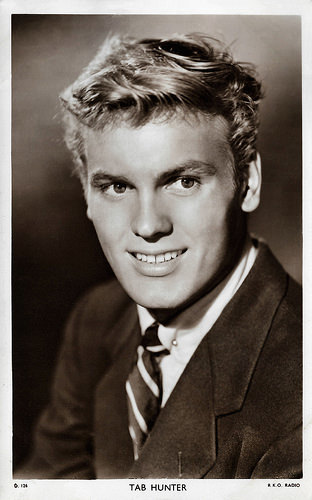
British postcard in the Picturegoer series, London, no. D 126. Photo: R.K.O. Radio.

Spanish postcard by Archivo Bermejo, no. 5495. Photo: Warner Bros. Publicity still for Lafayette Escadrille (William A Wellman, 1958).
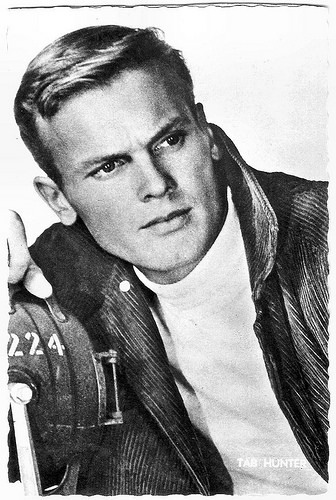
Dutch postcard by Int. Filmpers (IFP), Amsterdam, no. 1144.

Vintage postcard, no. 2311.
Fetching handsomeness and trim, athletic physique
Tab Hunter was born Arthur Andrew Kelm in New York City, in 1931. He was the son of Gertrude (Gelien) and Charles Kelm. Hunter's father was an abusive man and within a few years of his birth, his parents divorced and his mother moved with her two sons to California. Tab’s older brother Walter John Gelien (1930) would die in Vietnam in 1965 leaving seven children.
As a teenager, Hunter was a figure skater, competing in both singles and pairs. He joined the U.S. Coast Guard at the age of 15, lying about his age to enlist. While in the Coast Guard, he gained the nickname ‘Hollywood’ for his penchant for watching movies rather than going to bars while on liberty. He was eventually discharged when the age deception was revealed.
Returning home, his life-long passion for horseback riding led to a job with a riding academy. He was given the stage name Tab Hunter by his first agent, Henry Willson. With no previous experience Tab made his first, albeit minor, film debut in the racially trenchant drama The Lawless (Joseph Losey, 1950) starring Gail Russell. His fetching handsomeness and trim, athletic physique landed him a role in the British production Saturday Island (Stuart Heisler, 1952) opposite Linda Darnell. His shirt remained off for a good portion of the film, which certainly did not go unnoticed, and he was signed by Warner Bros.
The Hollywood studio system artificially groomed him and nicknamed him ‘The Sigh Guy’. His co-starring role as young Marine Danny in the World War II drama Battle Cry (Raoul Walsh, 1955), made him one of Hollywood's top young romantic leads. In the film based on the Leon Uris novel, Hunter has an affair with an older woman (Dorothy Malone), but ends up marrying the girl next door (Mona Freeman).
In September 1955, the tabloid magazine Confidential reported Hunter's 1950 arrest following an L.A. raid on a ‘pajama party’ in Walnut Park. Tab was eventually fined $50 for a reduced ‘disorderly conduct’ charge after originally being charged with ‘idle, lewd or dissolute conduct.’ The article, and a second one focusing on Rory Calhoun's prison record, were the result of a deal Henry Willson had brokered with Confidential in exchange for not revealing his client Rock Hudson's sexual orientation.
Surprisingly this article had no negative effect on Hunter's career. His hit films of these years include The Burning Hills (Stuart Heisler, 1955) with Natalie Wood, The Girl He Left Behind (David Butler, 1956), and Gunman’s Walk (Phil Karlson, 1957) with Van Heflin. Hunter, James Dean, and Natalie Wood were the last of the actors placed under exclusive studio contract to Warner Bros.
In 1957, Hunter had a hit record with the song Young Love, which was #1 on the Billboard Hot 100 chart for six weeks and became one of the larger hits of the Rock & Roll era. Another hit record was Ninety-Nine Ways, which peaked at #11. His success prompted Jack L. Warner to enforce the actor's contract with the Warner Bros. studio by banning Dot Records, the label for which Hunter had recorded the single (and which was owned by rival Paramount Pictures), from releasing a follow-up album he had recorded for them. He established Warner Bros. Records specifically for Hunter.
In 1958, Hunter starred in the musical film Damn Yankees (George Abbott, Stanley Donen, 1958), in which he played Joe Hardy of Washington DC's American League baseball club. Another success was That Kind of Woman (Sidney Lumet, 1959) with Sophia Loren . Hunter was Warner Bros.' top money-grossing star from 1955 through 1959.
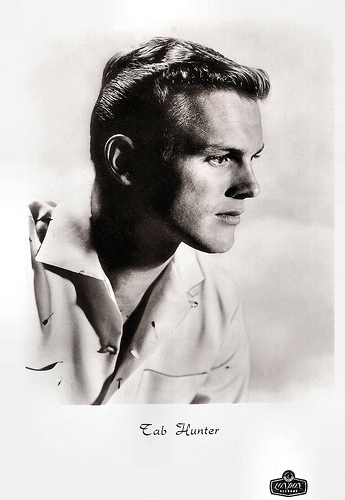
Dutch postcard by Gebr. Spanjersberg N.V., Rotterdam / Editions Altona, Amsterdam, no. 5128. Photo: London Records.
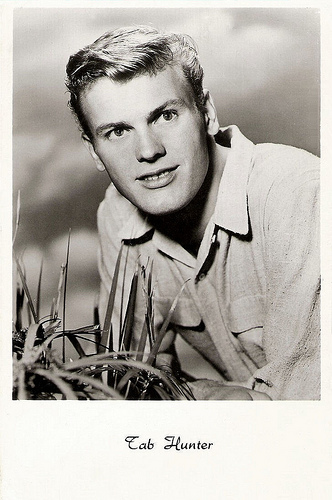
Dutch postcard by Gebr. Spanjersberg N.V., Rotterdam. Photo: Warner Bros Pictures.
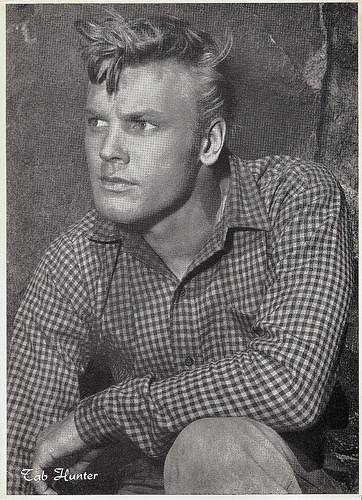
Vintage card.
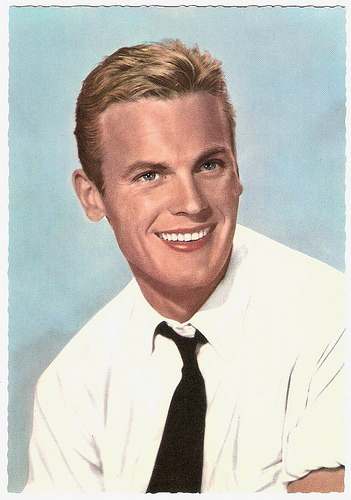
German postcard by ISV, no. H 51.
Spoofing his old clean-cut image
Tab Hunter's failure to win the role of Tony in the film adaptation of West Side Story (Jerome Robbins, Robert Wise, 1961) prompted him to agree to star in a weekly television sitcom. In 1960, prior to the program's debut, he was arrested by the police for allegedly beating his dog Fritz. His 11-day trial started in mid-October, a month after The Tab Hunter Show debuted on on NBC. The neighbour who initiated the charges had done so for spite when Hunter declined her repeated invitations to dinner, and he was acquitted by the jury. The Tab Hunter Show had moderate ratings and was cancelled after one season.
Following the film comedy The Pleasure of His Company (George Seaton, 1961) opposite Debbie Reynolds, the quality of his films fell off drastically during the 1960s. In Italy he made the fantasy L'arciere delle mille e una notte/The Golden Arrow (Antonio Margheriti, 1962) with Rossana Podestà . In Great Britain he starred in The City Under the Sea (Jacques Tourneur, 1965) with Vincent Price. For a short time in the late 1960s, after several seasons of starring in summer stock and dinner theatre in shows such as Bye Bye Birdie, The Tender Trap and Under the Yum Yum Tree.
Hunter settled in the south of France, and acted in Spaghetti Westerns like El dedo del destino/The Cups of San Sebastian (Richard Rush, 1967) and La vendetta è il mio perdono/Shotgun (Roberto Mauri, 1968). During the 1970 he worked mainly for TV but also starred in the horror film Sweet Kill (Curtis Hanson, 1972) and appeared in the Western The Life and Times of Judge Roy Bean (John Huston, 1972).
His career was revived in the 1980s, when he spoofed his old clean-cut image by appearing opposite Divine in the camp classics Polyester (John Waters, 1981) and Lust in the Dust (Paul Bartel, 1985), which Hunter also co-produced. He then played Mr. Stewart, the substitute teacher in Grease 2 (Patricia Birch, 1982), who sang Reproduction. Hunter had a major role in the horror film Cameron's Closet (Armand Mastroianni, 1988). He also wrote, co-produced and starred in Dark Horse (David Hemmings, 1992).
Hunter's autobiography, Tab Hunter Confidential: The Making of a Movie Star (2006), co-written with Eddie Muller, became a New York Times best-seller as did the paperback edition in 2007. In the book, Hunter acknowledged that he was gay, confirming rumours that had circulated since the height of his fame. According to William L. Hamilton of The New York Times, detailed reports about Hunter's alleged romances with close friends Debbie Reynolds and Natalie Wood, were strictly the fodder of studio publicity departments. Hunter had a long-term relationship with actor Anthony Perkins and shorter flings with dancer Rudolf Nureyev and champion figure skater Ronnie Robertson, before settling down with his partner of over 30 years, Allan Glaser.
In 2015 Glaser produced the documentary Tab Hunter Confidential (Jeffrey Schwarz, 2015), based on Hunter’s autobiography, which re-entered the New York Times Best Seller list during the release of the documentary.
Trailer for Damn Yankees (1958). Source: Tab Hunter (YouTube).
Tab Hunter sings Young Love Live at The Perry Como Show. Source: The Land Of Marcos (YouTube).
Trailer Polyester (1981). Source: Night of the Trailers (YouTube).
Trailer Tab Hunter Confidential (2015). Source: Vanity Fair (YouTube).
Sources: (IMDb), BBC, Wikipedia, and .

British postcard in the Picturegoer series, London, no. D 126. Photo: R.K.O. Radio.

Spanish postcard by Archivo Bermejo, no. 5495. Photo: Warner Bros. Publicity still for Lafayette Escadrille (William A Wellman, 1958).

Dutch postcard by Int. Filmpers (IFP), Amsterdam, no. 1144.

Vintage postcard, no. 2311.
Fetching handsomeness and trim, athletic physique
Tab Hunter was born Arthur Andrew Kelm in New York City, in 1931. He was the son of Gertrude (Gelien) and Charles Kelm. Hunter's father was an abusive man and within a few years of his birth, his parents divorced and his mother moved with her two sons to California. Tab’s older brother Walter John Gelien (1930) would die in Vietnam in 1965 leaving seven children.
As a teenager, Hunter was a figure skater, competing in both singles and pairs. He joined the U.S. Coast Guard at the age of 15, lying about his age to enlist. While in the Coast Guard, he gained the nickname ‘Hollywood’ for his penchant for watching movies rather than going to bars while on liberty. He was eventually discharged when the age deception was revealed.
Returning home, his life-long passion for horseback riding led to a job with a riding academy. He was given the stage name Tab Hunter by his first agent, Henry Willson. With no previous experience Tab made his first, albeit minor, film debut in the racially trenchant drama The Lawless (Joseph Losey, 1950) starring Gail Russell. His fetching handsomeness and trim, athletic physique landed him a role in the British production Saturday Island (Stuart Heisler, 1952) opposite Linda Darnell. His shirt remained off for a good portion of the film, which certainly did not go unnoticed, and he was signed by Warner Bros.
The Hollywood studio system artificially groomed him and nicknamed him ‘The Sigh Guy’. His co-starring role as young Marine Danny in the World War II drama Battle Cry (Raoul Walsh, 1955), made him one of Hollywood's top young romantic leads. In the film based on the Leon Uris novel, Hunter has an affair with an older woman (Dorothy Malone), but ends up marrying the girl next door (Mona Freeman).
In September 1955, the tabloid magazine Confidential reported Hunter's 1950 arrest following an L.A. raid on a ‘pajama party’ in Walnut Park. Tab was eventually fined $50 for a reduced ‘disorderly conduct’ charge after originally being charged with ‘idle, lewd or dissolute conduct.’ The article, and a second one focusing on Rory Calhoun's prison record, were the result of a deal Henry Willson had brokered with Confidential in exchange for not revealing his client Rock Hudson's sexual orientation.
Surprisingly this article had no negative effect on Hunter's career. His hit films of these years include The Burning Hills (Stuart Heisler, 1955) with Natalie Wood, The Girl He Left Behind (David Butler, 1956), and Gunman’s Walk (Phil Karlson, 1957) with Van Heflin. Hunter, James Dean, and Natalie Wood were the last of the actors placed under exclusive studio contract to Warner Bros.
In 1957, Hunter had a hit record with the song Young Love, which was #1 on the Billboard Hot 100 chart for six weeks and became one of the larger hits of the Rock & Roll era. Another hit record was Ninety-Nine Ways, which peaked at #11. His success prompted Jack L. Warner to enforce the actor's contract with the Warner Bros. studio by banning Dot Records, the label for which Hunter had recorded the single (and which was owned by rival Paramount Pictures), from releasing a follow-up album he had recorded for them. He established Warner Bros. Records specifically for Hunter.
In 1958, Hunter starred in the musical film Damn Yankees (George Abbott, Stanley Donen, 1958), in which he played Joe Hardy of Washington DC's American League baseball club. Another success was That Kind of Woman (Sidney Lumet, 1959) with Sophia Loren . Hunter was Warner Bros.' top money-grossing star from 1955 through 1959.

Dutch postcard by Gebr. Spanjersberg N.V., Rotterdam / Editions Altona, Amsterdam, no. 5128. Photo: London Records.

Dutch postcard by Gebr. Spanjersberg N.V., Rotterdam. Photo: Warner Bros Pictures.

Vintage card.

German postcard by ISV, no. H 51.
Spoofing his old clean-cut image
Tab Hunter's failure to win the role of Tony in the film adaptation of West Side Story (Jerome Robbins, Robert Wise, 1961) prompted him to agree to star in a weekly television sitcom. In 1960, prior to the program's debut, he was arrested by the police for allegedly beating his dog Fritz. His 11-day trial started in mid-October, a month after The Tab Hunter Show debuted on on NBC. The neighbour who initiated the charges had done so for spite when Hunter declined her repeated invitations to dinner, and he was acquitted by the jury. The Tab Hunter Show had moderate ratings and was cancelled after one season.
Following the film comedy The Pleasure of His Company (George Seaton, 1961) opposite Debbie Reynolds, the quality of his films fell off drastically during the 1960s. In Italy he made the fantasy L'arciere delle mille e una notte/The Golden Arrow (Antonio Margheriti, 1962) with Rossana Podestà . In Great Britain he starred in The City Under the Sea (Jacques Tourneur, 1965) with Vincent Price. For a short time in the late 1960s, after several seasons of starring in summer stock and dinner theatre in shows such as Bye Bye Birdie, The Tender Trap and Under the Yum Yum Tree.
Hunter settled in the south of France, and acted in Spaghetti Westerns like El dedo del destino/The Cups of San Sebastian (Richard Rush, 1967) and La vendetta è il mio perdono/Shotgun (Roberto Mauri, 1968). During the 1970 he worked mainly for TV but also starred in the horror film Sweet Kill (Curtis Hanson, 1972) and appeared in the Western The Life and Times of Judge Roy Bean (John Huston, 1972).
His career was revived in the 1980s, when he spoofed his old clean-cut image by appearing opposite Divine in the camp classics Polyester (John Waters, 1981) and Lust in the Dust (Paul Bartel, 1985), which Hunter also co-produced. He then played Mr. Stewart, the substitute teacher in Grease 2 (Patricia Birch, 1982), who sang Reproduction. Hunter had a major role in the horror film Cameron's Closet (Armand Mastroianni, 1988). He also wrote, co-produced and starred in Dark Horse (David Hemmings, 1992).
Hunter's autobiography, Tab Hunter Confidential: The Making of a Movie Star (2006), co-written with Eddie Muller, became a New York Times best-seller as did the paperback edition in 2007. In the book, Hunter acknowledged that he was gay, confirming rumours that had circulated since the height of his fame. According to William L. Hamilton of The New York Times, detailed reports about Hunter's alleged romances with close friends Debbie Reynolds and Natalie Wood, were strictly the fodder of studio publicity departments. Hunter had a long-term relationship with actor Anthony Perkins and shorter flings with dancer Rudolf Nureyev and champion figure skater Ronnie Robertson, before settling down with his partner of over 30 years, Allan Glaser.
In 2015 Glaser produced the documentary Tab Hunter Confidential (Jeffrey Schwarz, 2015), based on Hunter’s autobiography, which re-entered the New York Times Best Seller list during the release of the documentary.
Trailer for Damn Yankees (1958). Source: Tab Hunter (YouTube).
Tab Hunter sings Young Love Live at The Perry Como Show. Source: The Land Of Marcos (YouTube).
Trailer Polyester (1981). Source: Night of the Trailers (YouTube).
Trailer Tab Hunter Confidential (2015). Source: Vanity Fair (YouTube).
Sources: (IMDb), BBC, Wikipedia, and .
Published on July 09, 2018 14:57
July 8, 2018
Gianluca Grignani
Italian singer-songwriter Gianluca Grignani (1972) was a teen idol during the 1990s. He also starred in the film Branchie (1999).
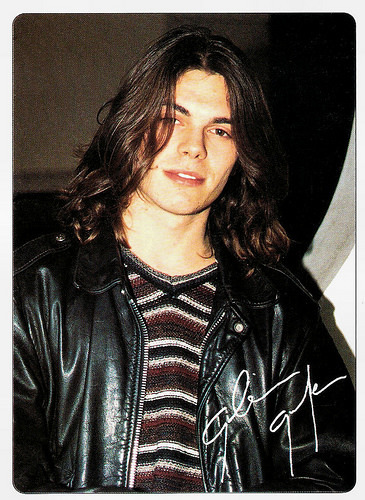
Italian postcard by Cloè, no. 29, 1995.
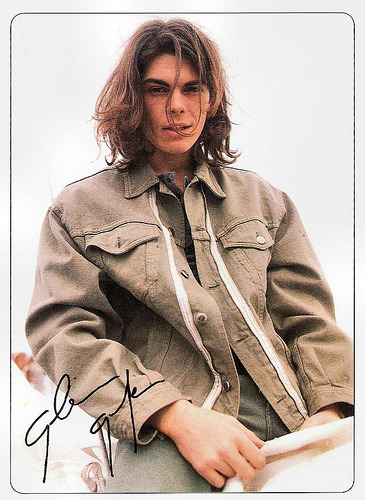
Italian postcard by Cloè, no. 29, 1995.
Writing songs in his room
Gianluca Grignani was born in in Milan, Italy in 1972. He was raised by his mother and with the help of his uncle he learned to play the guitar.
Grignani began writing songs in his room. He moved to London at the age of 17 and made contacts with several musicians, but returned to Italy several years later.
His musical career took off after meeting guitarist and producer Massimo Luca. After Grignani performed at the 1994 Festival de San Remo, he released the acoustic ballad La mia storia tra le dita.
In 1995, the handsome Grignani had his breakthrough with the album Destinazione Paradiso, which sold two million copies within a year, and for which he was awarded the Telegatto award. La mia storia tra le dita became a hit in several Latin American and European countries.
Fabrica Di Plastica appeared one year later, and was followed by Campi Di Popcorn (1998).
In 1999 he starred in the film Branchie (Francesco Ranieri Martinotti, 1999) with Valentina Cervi and Christoph Buchholz. His debut did not lead to more films, but from then on he focused on his career as a singer-songwriter.
In 2003, he married Francesca Dall'Olio. They have four children.
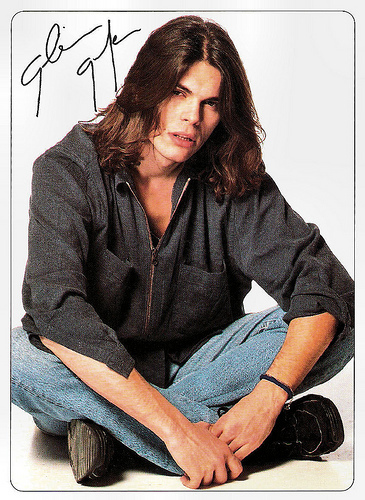
Italian postcard by Cloè, no. 29, 1995.
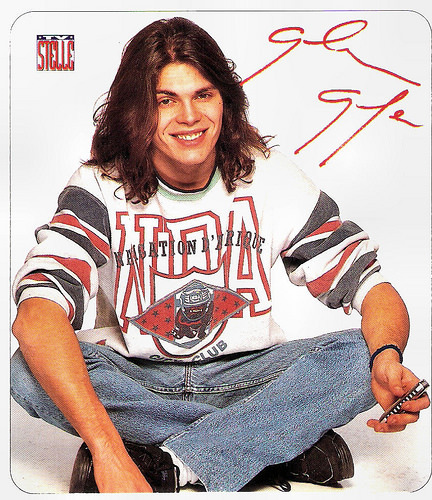
Italian postcard by TV Stelle.
Sources: John Bush (AllMovie), Wikipedia and IMDb.

Italian postcard by Cloè, no. 29, 1995.

Italian postcard by Cloè, no. 29, 1995.
Writing songs in his room
Gianluca Grignani was born in in Milan, Italy in 1972. He was raised by his mother and with the help of his uncle he learned to play the guitar.
Grignani began writing songs in his room. He moved to London at the age of 17 and made contacts with several musicians, but returned to Italy several years later.
His musical career took off after meeting guitarist and producer Massimo Luca. After Grignani performed at the 1994 Festival de San Remo, he released the acoustic ballad La mia storia tra le dita.
In 1995, the handsome Grignani had his breakthrough with the album Destinazione Paradiso, which sold two million copies within a year, and for which he was awarded the Telegatto award. La mia storia tra le dita became a hit in several Latin American and European countries.
Fabrica Di Plastica appeared one year later, and was followed by Campi Di Popcorn (1998).
In 1999 he starred in the film Branchie (Francesco Ranieri Martinotti, 1999) with Valentina Cervi and Christoph Buchholz. His debut did not lead to more films, but from then on he focused on his career as a singer-songwriter.
In 2003, he married Francesca Dall'Olio. They have four children.

Italian postcard by Cloè, no. 29, 1995.

Italian postcard by TV Stelle.
Sources: John Bush (AllMovie), Wikipedia and IMDb.
Published on July 08, 2018 22:00
July 7, 2018
Suzy Delair
Lively French entertainer Suzy Delair (1917) starred in many different films and was also famous in France as the singer of popular songs as Avec son Tra-la-la. For several years, the saucy star was the companion of film writer-director Henri-Georges Clouzot, in whose films of the 1940s she appeared, including the masterpiece Quai des Orfèvres/Quay of the Goldsmiths (1947).
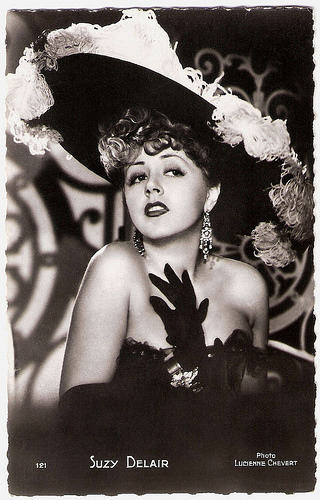
French postcard by Editions P.I., offered by Les Carbones Korès, no. 121. Photo: Lucienne Chevert. Publicity still for Quai des Orfèvres (Henri-Georges Clouzot, 1947).
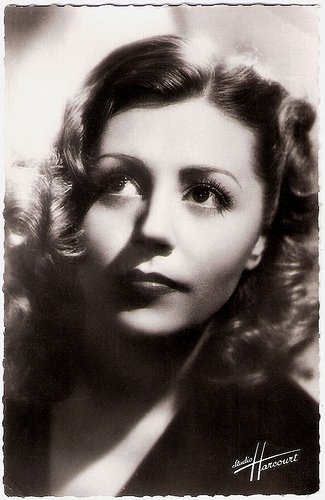
French postcard by Editions O.P., no. 4. Photo: Studio Harcourt.

French postcard by Editions du Globe, Paris, no. 128. Photo: Lucienne Chevert.
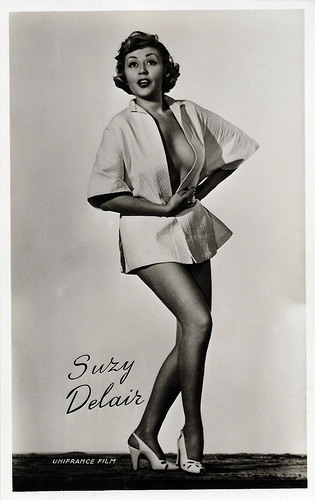
Dutch postcard, no. AX 850. Photo: Unifrance Film.
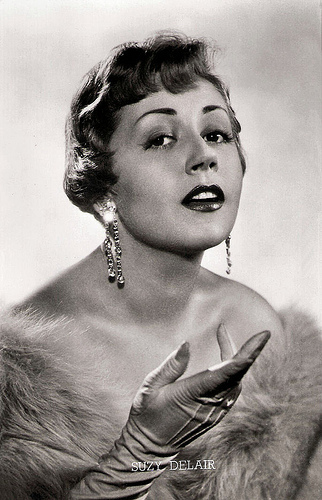
French postcard offered by Korès 'Carboplane', no. 153.
The prototype of the sexy cheeky French lady
Suzanne Pierrette Delaire was born in 1917, in Paris as the daughter of a seamstress and a saddleshop owner.
Her first job was as an apprentice for milliner Suzanne Talbot, but Delaire dreamed of the theatre. As a teenager she started playing bit parts in films and on stage.
Her film debut was Un caprice de la Pompadour/Madame Pompadour (Willy Wolff, Joë Hamman, 1930). She had her first success in the music-halls and appeared in the cabaret of Suzy Solidor and the revue of Mistinquett .
During the 1930s, she played small parts in films like La Dame de chez Maxim's (Alexander Korda, 1932) based on the play by farceur Georges Feydeau, Poliche (Abel Gance, 1934) with Marie Bell , and Prends la route/Hit the Road (Jean Boyer, 1936).
Finally, her breakthrough in the cinema came with Le Dernier des six/The Last One of the Six (Georges Lacombe, 1941). In this mystery thriller, she played cabaret singer Mila Malou, the unbearable girlfriend of the protagonist, inspector Wens ( Pierre Fresnay ).
The film was based on a script by Henri-Georges Clouzot, with whom Suzy Delair was living together. In 2003, the 85-year-old Delair told the New York Times about Clouzot: "He met me when I was a little debutante, working with Mistinquett . He adored Mistinquett , and he came to one of her shows, where I was singing one of her great successes, Valencia. And he put a cross next to my name. The next time he came to the show, he waited for me at the exit, and we went for a drink. And that lasted for 12 years."
When Clouzot became a director, he offered her two other big successes. First she returned in the popular sequel to Le Dernier des six, L'assassin habite au 21/The Murderer Lives at Number 21 (Henri-Georges Clouzot, 1942).
Then followed Quai des Orfèvres/Quay of the Goldsmiths (Henri-Georges Clouzot, 1947), which made him the 'French Alfred Hitchcock'. In this classic thriller, Delair played the frivolous music-hall singer Jenny L'Amour who is prepared to do anything to become famous, and makes thus her poor husband ( Bernard Blier ) insanely jealous.
With this great part she emerged to international stardom. At IMDb , Guy Bellinger describes her as the 'prototype of the sexy cheeky French lady'. She was a seductive, stunningly attractive actress with a natural acting style. Sadly, Delair and Clouzot separated and after their successes together, the rest of her film career seems a bit disappointing. However, there are some exceptions.

French postcard, no. 14. Photo: Discina.
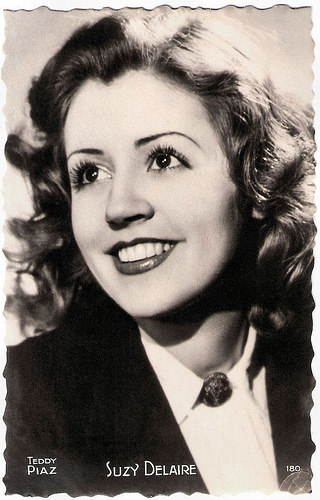
French postcard by Editions O.P., no. 180. Photo: Teddy Piaz.
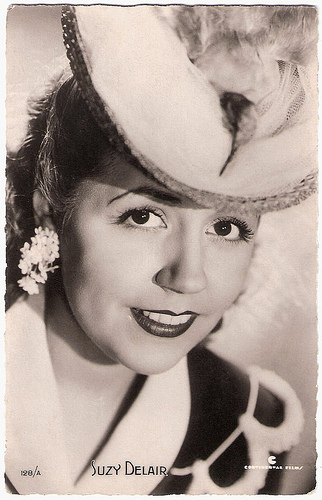
French postcard by Editions Continental, no. 128/A. Photo: Continental Films.
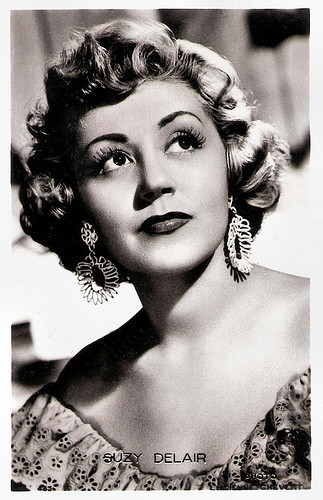
French postcard offered by Editions P.I., no. 13 F. Photo: Lucienne Chevert.
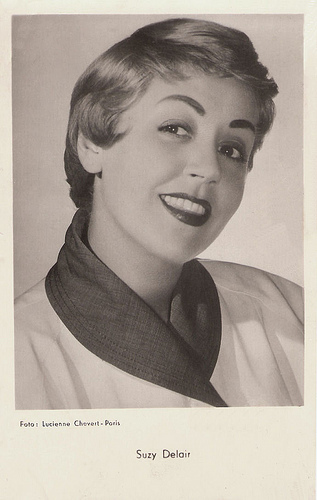
French postcard by Editions P.I., Paris, no. 29 H. P.I. was the French licency holder for Universum-Film A.G. (UFA), Berlin-Tempelhof. Photo: Lucienne Chevert.
Avec son Tra-la-la
After the war, Suzy Delair starred in films by major directors like Marcel L'Herbier (La Vie de bohème, 1945), Jean Dréville (Copie conforme/Confessions of a Rogue, 1947), Marcel Carné (Du mouron pour les petits oiseaux/Chicken Feed for Little Birds, 1962), and René Clément (Paris brûle-t-il?/Is Paris Burning?, 1966).
A highlight in her career and a milestone in the history of the cinema was Rocco e i suoi fratelli/Rocco and His Brothers (Luchino Visconti, 1960) starring Alain Delon and Renato Salvatori , even if her part in this operatic masterpiece is a minor one.
Delair covered all registers - from drama to comedy. Ironically, Suzy is probably best known to American filmgoers for what may well be her worst film. In 1950, she appeared as will-of-the-wisp chanteuse Cheri Lamour in the last comedy os the ageing Laurel & Hardy , the melancholy Atoll K/Utopia (Léo Joannon, 1951).
She also appeared in the Fernandel vehicle Le Couturier de ces Dames/Fernandel the Dress Maker (Jean Boyer, 1956) and in the hilarious farce Les Aventures de Rabbi Jacob/The Mad Adventures of Rabbi Jacob (Gérard Oury, 1973) starring French comedy star Louis de Funès .
She was a dancer and a singer, and her chanson Avec son Tra-la-la is an evergreen in France. She introduced it in Quai des Orfèvres (1947). Delair also appeared in several operettas by Jacques Offenbach and Oscar and Johan Strauss.
Her last film was Oublie-moi, Mandoline/Forget Me, Mandoline (Michel Wyn, 1976). Since then Suzy Delair only appeared incidentally on television.
Guy Bellinger gives an interesting answer to why Delair is not more famous than she is: "Suzy Delair could hardly choose between her two careers. This may be the reason why she missed out on more great roles than she finally interpreted. Nevertheless, Mila Malou and Jenny Lamour are now part of the French film heritage. Not everybody can boast having left such an imprint on several generations of movie-goers."
Trailer for Quai des Orfèvres (1947). Source: YouTube Movies (YouTube).
Snippet from Atoll K/Utopia (1951). Source: httpdbetreeorg (YouTube).
Suzy Delair sings Moulin rouge in 1966. Source: Ina Chansons (YouTube).
Trailer of Les Aventures de Rabbi Jacob (1973). Source: Night Of The Trailers (YouTube).
Sources: (IMDb), Hal Erickson (AllMovie), Movie Diva, Wikipedia (English and French) and .

French postcard by Editions P.I., offered by Les Carbones Korès, no. 121. Photo: Lucienne Chevert. Publicity still for Quai des Orfèvres (Henri-Georges Clouzot, 1947).

French postcard by Editions O.P., no. 4. Photo: Studio Harcourt.

French postcard by Editions du Globe, Paris, no. 128. Photo: Lucienne Chevert.

Dutch postcard, no. AX 850. Photo: Unifrance Film.

French postcard offered by Korès 'Carboplane', no. 153.
The prototype of the sexy cheeky French lady
Suzanne Pierrette Delaire was born in 1917, in Paris as the daughter of a seamstress and a saddleshop owner.
Her first job was as an apprentice for milliner Suzanne Talbot, but Delaire dreamed of the theatre. As a teenager she started playing bit parts in films and on stage.
Her film debut was Un caprice de la Pompadour/Madame Pompadour (Willy Wolff, Joë Hamman, 1930). She had her first success in the music-halls and appeared in the cabaret of Suzy Solidor and the revue of Mistinquett .
During the 1930s, she played small parts in films like La Dame de chez Maxim's (Alexander Korda, 1932) based on the play by farceur Georges Feydeau, Poliche (Abel Gance, 1934) with Marie Bell , and Prends la route/Hit the Road (Jean Boyer, 1936).
Finally, her breakthrough in the cinema came with Le Dernier des six/The Last One of the Six (Georges Lacombe, 1941). In this mystery thriller, she played cabaret singer Mila Malou, the unbearable girlfriend of the protagonist, inspector Wens ( Pierre Fresnay ).
The film was based on a script by Henri-Georges Clouzot, with whom Suzy Delair was living together. In 2003, the 85-year-old Delair told the New York Times about Clouzot: "He met me when I was a little debutante, working with Mistinquett . He adored Mistinquett , and he came to one of her shows, where I was singing one of her great successes, Valencia. And he put a cross next to my name. The next time he came to the show, he waited for me at the exit, and we went for a drink. And that lasted for 12 years."
When Clouzot became a director, he offered her two other big successes. First she returned in the popular sequel to Le Dernier des six, L'assassin habite au 21/The Murderer Lives at Number 21 (Henri-Georges Clouzot, 1942).
Then followed Quai des Orfèvres/Quay of the Goldsmiths (Henri-Georges Clouzot, 1947), which made him the 'French Alfred Hitchcock'. In this classic thriller, Delair played the frivolous music-hall singer Jenny L'Amour who is prepared to do anything to become famous, and makes thus her poor husband ( Bernard Blier ) insanely jealous.
With this great part she emerged to international stardom. At IMDb , Guy Bellinger describes her as the 'prototype of the sexy cheeky French lady'. She was a seductive, stunningly attractive actress with a natural acting style. Sadly, Delair and Clouzot separated and after their successes together, the rest of her film career seems a bit disappointing. However, there are some exceptions.

French postcard, no. 14. Photo: Discina.

French postcard by Editions O.P., no. 180. Photo: Teddy Piaz.

French postcard by Editions Continental, no. 128/A. Photo: Continental Films.

French postcard offered by Editions P.I., no. 13 F. Photo: Lucienne Chevert.

French postcard by Editions P.I., Paris, no. 29 H. P.I. was the French licency holder for Universum-Film A.G. (UFA), Berlin-Tempelhof. Photo: Lucienne Chevert.
Avec son Tra-la-la
After the war, Suzy Delair starred in films by major directors like Marcel L'Herbier (La Vie de bohème, 1945), Jean Dréville (Copie conforme/Confessions of a Rogue, 1947), Marcel Carné (Du mouron pour les petits oiseaux/Chicken Feed for Little Birds, 1962), and René Clément (Paris brûle-t-il?/Is Paris Burning?, 1966).
A highlight in her career and a milestone in the history of the cinema was Rocco e i suoi fratelli/Rocco and His Brothers (Luchino Visconti, 1960) starring Alain Delon and Renato Salvatori , even if her part in this operatic masterpiece is a minor one.
Delair covered all registers - from drama to comedy. Ironically, Suzy is probably best known to American filmgoers for what may well be her worst film. In 1950, she appeared as will-of-the-wisp chanteuse Cheri Lamour in the last comedy os the ageing Laurel & Hardy , the melancholy Atoll K/Utopia (Léo Joannon, 1951).
She also appeared in the Fernandel vehicle Le Couturier de ces Dames/Fernandel the Dress Maker (Jean Boyer, 1956) and in the hilarious farce Les Aventures de Rabbi Jacob/The Mad Adventures of Rabbi Jacob (Gérard Oury, 1973) starring French comedy star Louis de Funès .
She was a dancer and a singer, and her chanson Avec son Tra-la-la is an evergreen in France. She introduced it in Quai des Orfèvres (1947). Delair also appeared in several operettas by Jacques Offenbach and Oscar and Johan Strauss.
Her last film was Oublie-moi, Mandoline/Forget Me, Mandoline (Michel Wyn, 1976). Since then Suzy Delair only appeared incidentally on television.
Guy Bellinger gives an interesting answer to why Delair is not more famous than she is: "Suzy Delair could hardly choose between her two careers. This may be the reason why she missed out on more great roles than she finally interpreted. Nevertheless, Mila Malou and Jenny Lamour are now part of the French film heritage. Not everybody can boast having left such an imprint on several generations of movie-goers."
Trailer for Quai des Orfèvres (1947). Source: YouTube Movies (YouTube).
Snippet from Atoll K/Utopia (1951). Source: httpdbetreeorg (YouTube).
Suzy Delair sings Moulin rouge in 1966. Source: Ina Chansons (YouTube).
Trailer of Les Aventures de Rabbi Jacob (1973). Source: Night Of The Trailers (YouTube).
Sources: (IMDb), Hal Erickson (AllMovie), Movie Diva, Wikipedia (English and French) and .
Published on July 07, 2018 22:00
July 6, 2018
Photo by Angelo
Hungarian Pál Funk (1894-1974) was under the name of Angelo a leading photographer of European celebrities during the 1920s and 1930s. The glamorous film star portraits of his Angelo Photos studio graced countless European postcards.
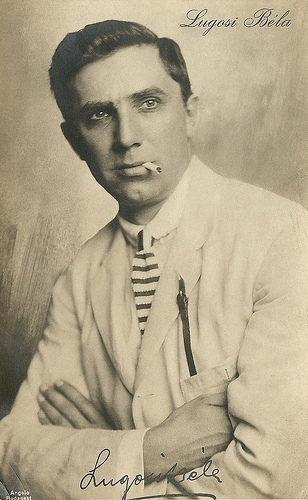
Béla Lugosi . Hungarian postcard. Photo: Angelo, Budapest. Collection: Didier Hanson.
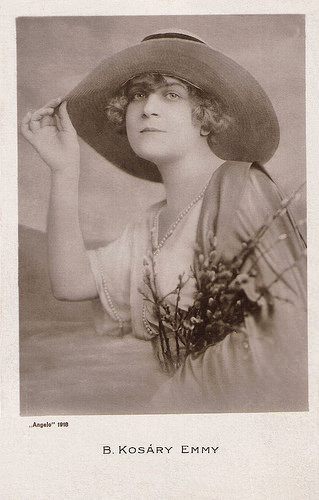
Emmi Kosáry . Hungarian postcard by Kiadja Reinitz Jòzsef, Budapest. Photo: Angelo, 1918.
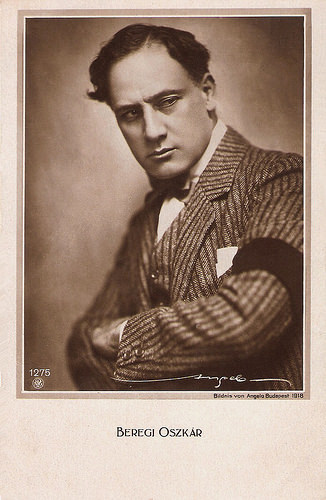
Oscar Beregi Sr. German postcard by NPG, no. 1275 Photo: Angelo, Budapest, 1918.
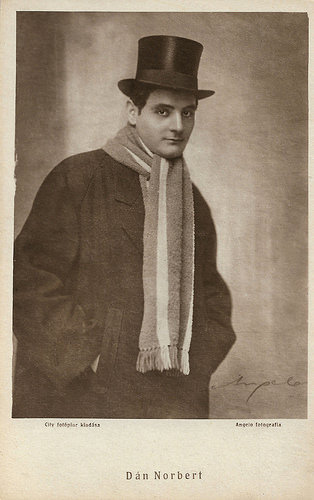
Norbert Dán. Hungarian postcard by City Fotoplar Kladása. Photo: Angelo Fotografia.
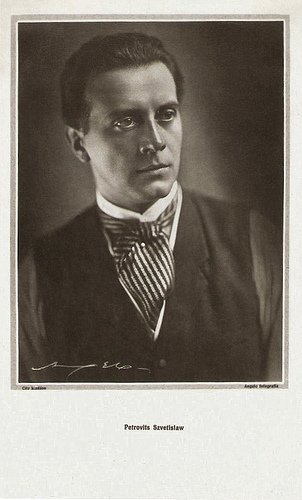
Iván Petrovich . Hungarian postcard by City Kindasa. Photo: Angelo Fotografia.
The First Hungarian Talking Pictures
Pál Funk was born in Budapest, Hungary in 1894. Among the names he used internationally are P. F. Angelo, Angelo Pál, Paul Angelo, Funk Pál, and Funk Pinkász.
In his family history were many famous sculptors, painters and graphic artists. His Italian great-grandfather, Alessandro Angelo was responsible for the stuccos of the Viennese Hofburg in the 18th century.
Between 1902 and 1912, Pál Funk did his primary and secondary studies in Budapest. In 1912 he entered the Academy of Fine Arts in Munich, Germany to study painting with Carl Bauer. There his attention was drawn to the new art form photography and he started to practice a camera.
Between 1912 and 1919 he studied in Berlin with Nicola Perscheid; in Hamburg in the Dührkoop studio of professor Peters; in London with Emil Oho Hoppe and Marcus Adams; and in Paris with Charles Reutlinger .
In Paris, he worked mostly as a fashion designer, but when the First World War broke out he had to return home. He was attracted by the cinema, and worked as an assistant director and cameraman for director Mihaly Kertesz - the future Hollywood director Michael Curtiz.
Funk’s film career would last for a decade. Every year he worked at the European Section of the Franco-British Film Corporation, and on MGM productions. He worked with Rex Ingram, Erich Pommer, Fritz Lang, Alexander Volkoff, and Ernst Lubitsch . In 1927 he would take part in the birth of the first Hungarian talking pictures with István Eiben.
In 1916 he also became first assistant in the studio of photographer Aladár Székely. After many attempts he opened his own more significant photo studio in Budapest in 1919, but the following year he had to flee due to the 'white terror.' The following years he opened photo ateliers across Europe.
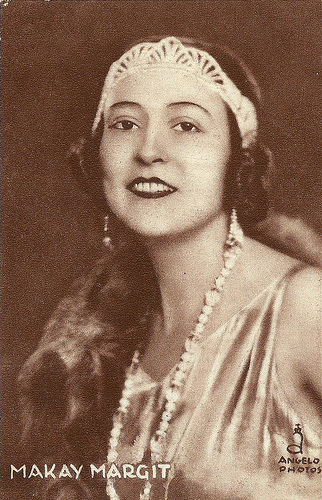
Margit Makay . Hungarian postcard by Globus, Budapest. Photo: Angelo Photos. Collection: Didier Hanson.
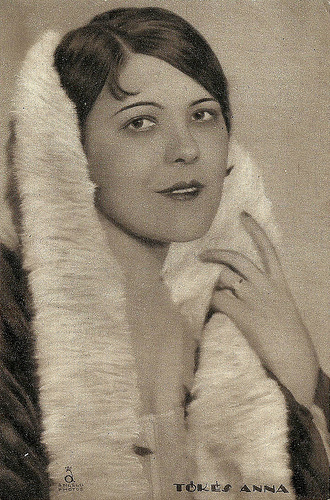
Anna Tõkés. Hungarian postcard by Globus, Budapest. Photo: Angelo Photos. Collection: Didier Hanson.
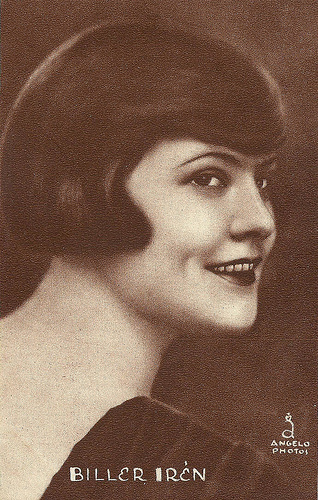
Irén Biller. Hungarian postcard by Globus, Budapest. Photo: Angelo Photos. Collection: Didier Hanson.
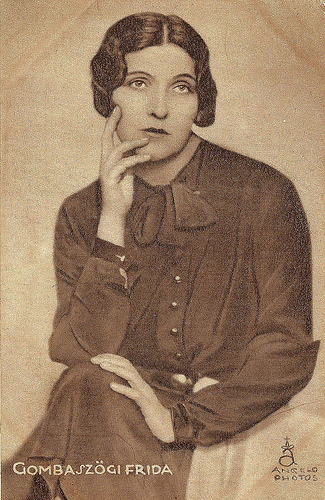
Frida Gombaszögi. Hungarian postcard by Globus, Budapest. Photo: Angelo Photos. Collection: Didier Hanson.
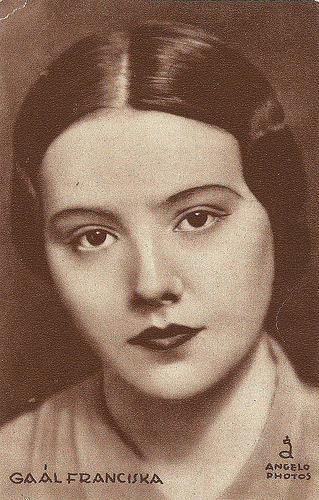
Franciska Gaál . Hungarian postcard by Globus, Budapest. Photo: Angelo Photos. Collection: Didier Hanson.
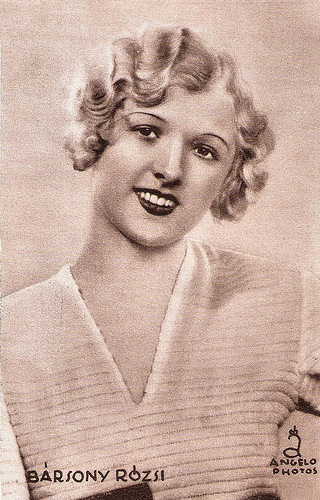
Rose Barsony . Hungarian postcard by Globus, Budapest. Photo: Angelo Photos.
A Master Of His Metier
Between 1920 and 1938, Pál Funk worked in the Netherlands, France and Hungary and he opened ateliers in The Hague, the Dutch sea resort Scheveningen, Paris and Nice, where he photographed celebrities and artists.
From 1923, he took part in international photo exhibitions and won many gold, silver and bronze medals. Respected newspapers and magazines like Vanity Fair, Harper’s Bazaar, and die Berliner Illustrierte Zeitung published his works. In 1926, The Royal Photographic Society of Great-Britain admitted him as one of its members.
Hungary honoured him with the Golden Crown in 1937 as a master of his metier. He returned to Hungary in 1939, where he worked as a teacher, a tireless organiser and creator. During his career, he taught more than fifty Hungarian photographers, who studied under his personal tutelage.
In 1951 his studio was nationalised and until he retired in 1964 Funk worked at the photographers cooperative in Budapest. At the same time he took photographs for himself to suit his artistic ambitions.
He was a founding member of the Association of Hungarian Photographers (1956). In 1958 he got the prize of the Federation Internationale de l’Art Photographique (EFIAP), then in 1969 he got the prize Honoraire Excellence.
Funk retired in 1964. During his fifty-year career as a studio photographer, he photographed over 450,000 people, including many of the major artistic influencers of his time like Gustav Mahler, Pablo Picasso, Charlie Chaplin , Josephine Baker , and Béla Bartók. He has been awarded the French Minister of Art’s award (1961) and the Niepce-Daguerre Medal (1960), among many other major awards.
In 1974, Pál Funk died in Budapest.
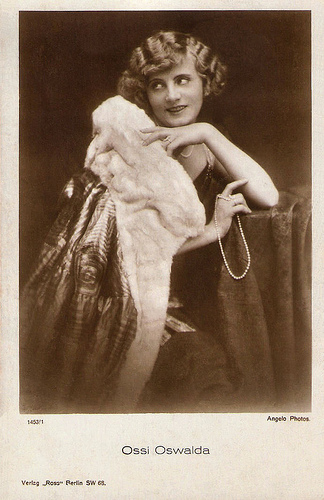
Ossi Oswalda . German postcard by Ross Verlag, Berlin, no. 1453/1, 1927-1928. Photo: Angelo Photos.
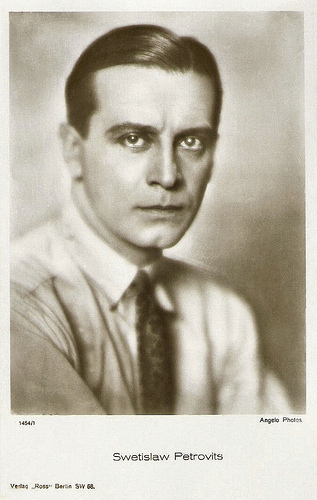
Iván Petrovich . German postcard by Ross Verlag, Berlin, no. 1454/1, 1927-1928. Photo: Angelo Photos.
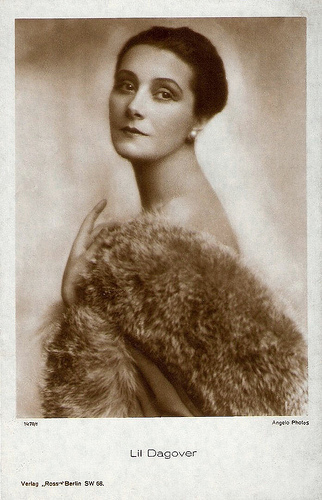
Lil Dagover . German postcard by Ross Verlag, Berlin, no. 1470/1, 1927-1928. Photo: Angelo Photos.
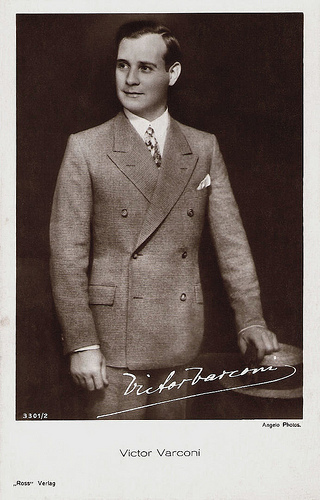
Victor Varconi . German postcard by Ross Verlag, no. 3301/2, 1928-1929. Photo: Angelo Photos.
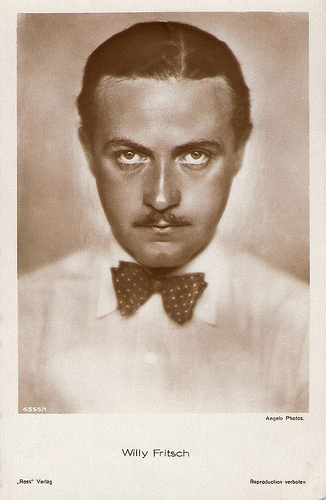
Willy Fritsch . German postcard by Ross Verlag, no. 4555/1, 1929-1930. Photo: Angelo Photos.
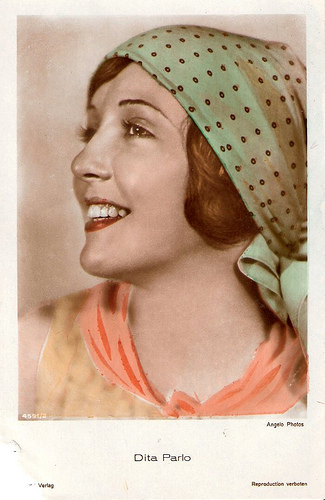
Dita Parlo . German postcard by Ross Verlag, no. 4591/2, 1929-1930. Photo: Angelo Photos.
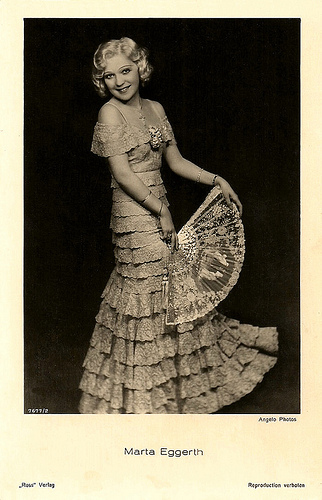
Márta Eggerth . German postcard by Ross Verlag, no. 7677/2, 1932-1933. Photo: Angelo Photos.
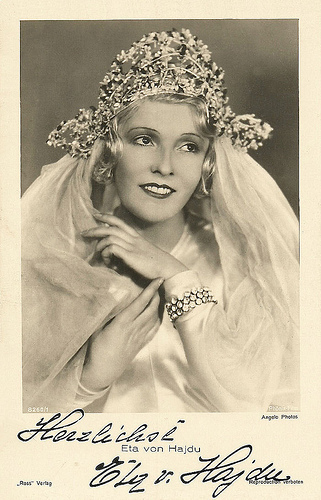
Eta von Hajdu. German postcard by Ross Verlag, no. 8260/1, 1933-1934. Photo: Angelo Photos / Phönix Film. Collection: Didier Hanson.
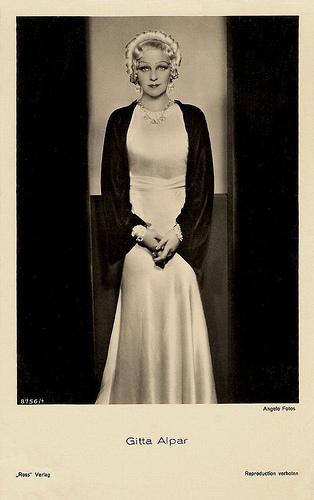
Gitta Alpár . German postcard by Ross Verlag, no. 8756/1, 1933-1934. Photo: Angelo Photos.
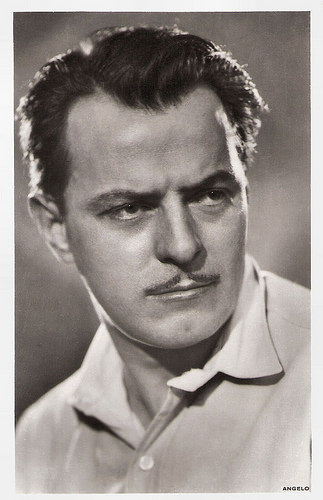
Pál Jávor . Hungarian postcard by Rakosi Kiado, Budapest, no. 602. Photo: Angelo.
Sources: Kincses Károly (Fotomuveszet), Wikipedia (Hungarian) and Didier Hanson.

Béla Lugosi . Hungarian postcard. Photo: Angelo, Budapest. Collection: Didier Hanson.

Emmi Kosáry . Hungarian postcard by Kiadja Reinitz Jòzsef, Budapest. Photo: Angelo, 1918.

Oscar Beregi Sr. German postcard by NPG, no. 1275 Photo: Angelo, Budapest, 1918.

Norbert Dán. Hungarian postcard by City Fotoplar Kladása. Photo: Angelo Fotografia.

Iván Petrovich . Hungarian postcard by City Kindasa. Photo: Angelo Fotografia.
The First Hungarian Talking Pictures
Pál Funk was born in Budapest, Hungary in 1894. Among the names he used internationally are P. F. Angelo, Angelo Pál, Paul Angelo, Funk Pál, and Funk Pinkász.
In his family history were many famous sculptors, painters and graphic artists. His Italian great-grandfather, Alessandro Angelo was responsible for the stuccos of the Viennese Hofburg in the 18th century.
Between 1902 and 1912, Pál Funk did his primary and secondary studies in Budapest. In 1912 he entered the Academy of Fine Arts in Munich, Germany to study painting with Carl Bauer. There his attention was drawn to the new art form photography and he started to practice a camera.
Between 1912 and 1919 he studied in Berlin with Nicola Perscheid; in Hamburg in the Dührkoop studio of professor Peters; in London with Emil Oho Hoppe and Marcus Adams; and in Paris with Charles Reutlinger .
In Paris, he worked mostly as a fashion designer, but when the First World War broke out he had to return home. He was attracted by the cinema, and worked as an assistant director and cameraman for director Mihaly Kertesz - the future Hollywood director Michael Curtiz.
Funk’s film career would last for a decade. Every year he worked at the European Section of the Franco-British Film Corporation, and on MGM productions. He worked with Rex Ingram, Erich Pommer, Fritz Lang, Alexander Volkoff, and Ernst Lubitsch . In 1927 he would take part in the birth of the first Hungarian talking pictures with István Eiben.
In 1916 he also became first assistant in the studio of photographer Aladár Székely. After many attempts he opened his own more significant photo studio in Budapest in 1919, but the following year he had to flee due to the 'white terror.' The following years he opened photo ateliers across Europe.

Margit Makay . Hungarian postcard by Globus, Budapest. Photo: Angelo Photos. Collection: Didier Hanson.

Anna Tõkés. Hungarian postcard by Globus, Budapest. Photo: Angelo Photos. Collection: Didier Hanson.

Irén Biller. Hungarian postcard by Globus, Budapest. Photo: Angelo Photos. Collection: Didier Hanson.

Frida Gombaszögi. Hungarian postcard by Globus, Budapest. Photo: Angelo Photos. Collection: Didier Hanson.

Franciska Gaál . Hungarian postcard by Globus, Budapest. Photo: Angelo Photos. Collection: Didier Hanson.

Rose Barsony . Hungarian postcard by Globus, Budapest. Photo: Angelo Photos.
A Master Of His Metier
Between 1920 and 1938, Pál Funk worked in the Netherlands, France and Hungary and he opened ateliers in The Hague, the Dutch sea resort Scheveningen, Paris and Nice, where he photographed celebrities and artists.
From 1923, he took part in international photo exhibitions and won many gold, silver and bronze medals. Respected newspapers and magazines like Vanity Fair, Harper’s Bazaar, and die Berliner Illustrierte Zeitung published his works. In 1926, The Royal Photographic Society of Great-Britain admitted him as one of its members.
Hungary honoured him with the Golden Crown in 1937 as a master of his metier. He returned to Hungary in 1939, where he worked as a teacher, a tireless organiser and creator. During his career, he taught more than fifty Hungarian photographers, who studied under his personal tutelage.
In 1951 his studio was nationalised and until he retired in 1964 Funk worked at the photographers cooperative in Budapest. At the same time he took photographs for himself to suit his artistic ambitions.
He was a founding member of the Association of Hungarian Photographers (1956). In 1958 he got the prize of the Federation Internationale de l’Art Photographique (EFIAP), then in 1969 he got the prize Honoraire Excellence.
Funk retired in 1964. During his fifty-year career as a studio photographer, he photographed over 450,000 people, including many of the major artistic influencers of his time like Gustav Mahler, Pablo Picasso, Charlie Chaplin , Josephine Baker , and Béla Bartók. He has been awarded the French Minister of Art’s award (1961) and the Niepce-Daguerre Medal (1960), among many other major awards.
In 1974, Pál Funk died in Budapest.

Ossi Oswalda . German postcard by Ross Verlag, Berlin, no. 1453/1, 1927-1928. Photo: Angelo Photos.

Iván Petrovich . German postcard by Ross Verlag, Berlin, no. 1454/1, 1927-1928. Photo: Angelo Photos.

Lil Dagover . German postcard by Ross Verlag, Berlin, no. 1470/1, 1927-1928. Photo: Angelo Photos.

Victor Varconi . German postcard by Ross Verlag, no. 3301/2, 1928-1929. Photo: Angelo Photos.

Willy Fritsch . German postcard by Ross Verlag, no. 4555/1, 1929-1930. Photo: Angelo Photos.

Dita Parlo . German postcard by Ross Verlag, no. 4591/2, 1929-1930. Photo: Angelo Photos.

Márta Eggerth . German postcard by Ross Verlag, no. 7677/2, 1932-1933. Photo: Angelo Photos.

Eta von Hajdu. German postcard by Ross Verlag, no. 8260/1, 1933-1934. Photo: Angelo Photos / Phönix Film. Collection: Didier Hanson.

Gitta Alpár . German postcard by Ross Verlag, no. 8756/1, 1933-1934. Photo: Angelo Photos.

Pál Jávor . Hungarian postcard by Rakosi Kiado, Budapest, no. 602. Photo: Angelo.
Sources: Kincses Károly (Fotomuveszet), Wikipedia (Hungarian) and Didier Hanson.
Published on July 06, 2018 22:00
July 5, 2018
Gaston Jacquet
Elegant French actor Gaston Jacquet (1883–1970) started his film career during the early silent film era. He played in many films of director Julien Duvivier during the 1920s and 1930s.
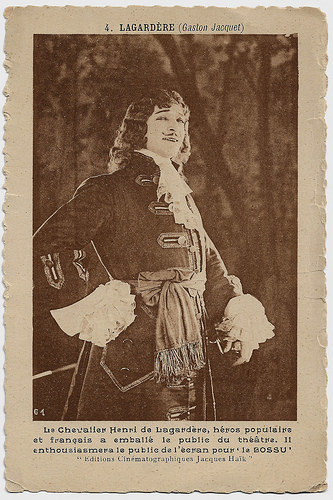
French postcard by Editions Cinématographiques Jacques Haïk, no. 4. Photo: Combier Mâcon. Gaston Jacquet as Le Chevalier Henri de Lagardère in Le Bossu/The Duke's Motto (Jean Kemm, 1925).
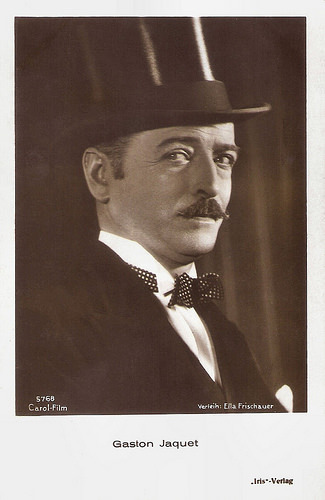
Austrian postcard by Iris Verlag, no. 5768. Photo: Verleih Ella Frischauer.
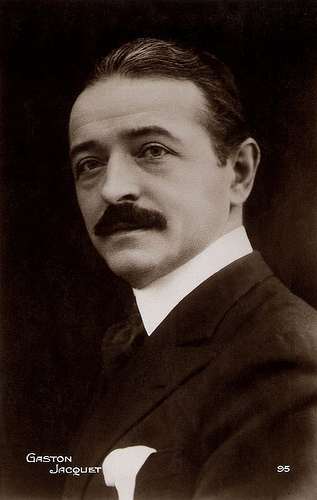
French postcard by Cinémagazine Edition, no. 95.
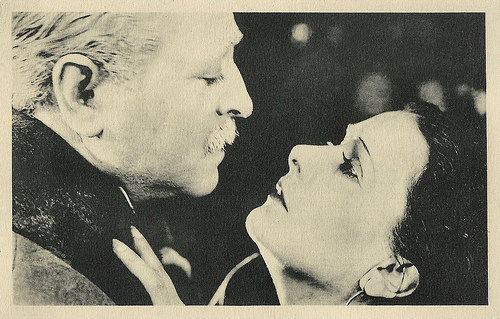
French postcard by Film français Aubert, Paris. Photo: publicity still for Le Tourbillon de Paris/The Maelstrom of Paris (Julien Duvivier, 1928) with Lil Dagover.
The Three Musketeers
Gaston Jacquet was born as Émile Marius Jacquet in Lanas, France in 1883.
He started his film career with such silent films as Qui a tué?/Who killed? (Pierre Marodon, 1919) with Elmire Vautier , Le sang des immortelles/The blood of the immortals (André Liabel, 1919) with Marcel Vibert , and Celle qui n'a pas dit son nom/The one who did not say her name (Maurice de Marsan, 1919).
In the early 1920s, he played in dozens of films, such as Les femmes des autres/The Wives of Others (Pierre Marodon, 1920) starring Renée Sylvaire , as De Winter in Les trois mousquetaires/The Three Musketeers (Henri Diamant-Berger, 1921) with Aimé Simon-Girard as D’Artagnan, and L'ouragan sur la montagne/The Hurricane on the Mountain (1922), directed by the young Julien Duvivier.
He also starred in Duvivier’s Le reflet de Claude Mercoeur/The Reflection of Claude Mercoeur (Julien Duvivier, 1923) starring Camille Beuve, Coeurs farouches/Wild hearts (Julien Duvivier, 1924) with Rolla Norman , and Credo ou la tragédie de Lourdes/Credo or The Tragedy of Lourdes (Julien Duvivier, 1924).
Their biggest success was the funny extravaganza Le mystère de la tour Eiffel/The Mystery of the Eiffel Tower (Julien Duvivier, 1927) with the boy Jimmy Gaillard , who would become an actor when he grew up.
DB DuMonteil at IMDb about the sole remaining copy in the Dutch Eye Institute: “The best of what remains of the original work is the final scenes, on the Eiffel Tower, where Duvivier already showed he would be one of the greatest French directors of all time. He filmed the famous tower in a way that is almost frightening: the steel frames, the cables, everything creates a new world where men are like spiders on a giant web, while the crowd looks like ants on the Champ De Mars.”
The following year they worked again together at L'agonie de Jérusalem/The Agony of Jerusalem (Julien Duvivier, 1928) and Le tourbillon de Paris/The Maelstrom of Paris (Julien Duvivier, 1928) with German star Lil Dagover .
Jacquet also played supporting parts in German silent films, such as the Anny Ondra comedies Der erste Kuß/The First Kiss (Carl Lamac, 1928) and Saxophon-Susi/Suzy Saxaphone (Carl Lamac, 1928), and in Großstadtschmetterling/Pavement Butterfly (Richard Eichberg, 1929) starring Anna May Wong .
One of his last silent films was Prix de beauté/Beauty Prize (Augusto Genina, 1930) about which James Travers at Films de France writes: “Prix de beauté was one of the last silent masterpieces, directed by Augusto Genina and scripted by René Clair (himself a great director). Released at a time when sound films were becoming the norm, this film was largely overlooked and has only comparatively recently received the attention it deserves. The film stars Louise Brooks in the role of the eponymous tragic femme fatale, a part that suits the beautiful young actress perfectly.”
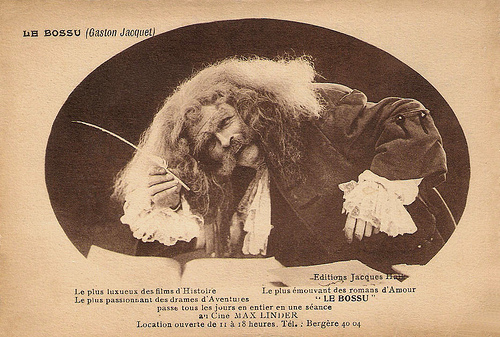
French postcard by Editions Jacques Haïk. Photo: Combier Mâcon. Publicity still for Le Bossu/The Duke's Motto (Jean Kemm, 1925).
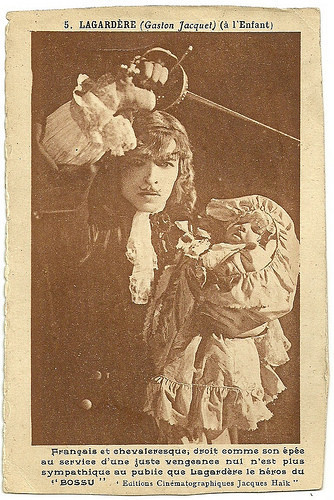
French postcard by Editions Jacques Haïk, no. 5. Photo: Combier Mâcon. Publicity still for Le Bossu/The Duke's Motto (Jean Kemm, 1925). Caption: "Lagardère {à L'Enfant" (Young) Lagardère).
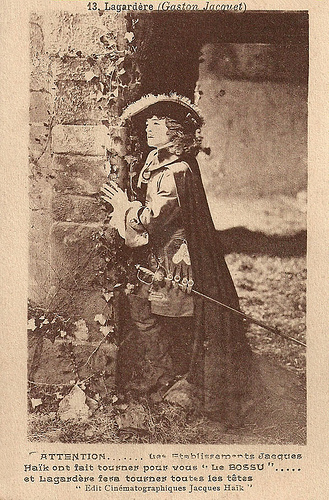
French postcard by Editions Jacques Haïk, no. 13. Photo: Combier Mâcon. Publicity still for Le Bossu/The Duke's Motto (Jean Kemm, 1925). Caption: Lagardère (Gaston Jacquet). 'Les Etablissements Jacques Haïk ont fait tourner pour vous "Le Bossu"... et Lagardère fera tourner toutes les têtes.' (Jacques Haïk company made Le Bossu for you ... and Lagardère will make all heads turn.)
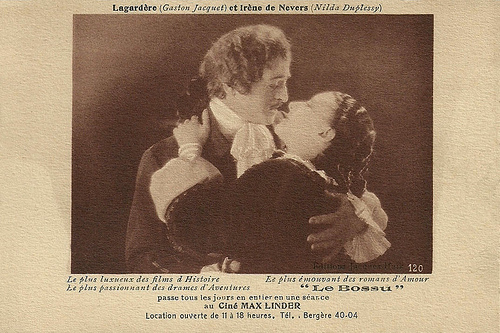
French postcard by Editions Jacques Haïk, no. 120. Photo: Combier Mâcon. Publicity still for Le Bossu/The Duke's Motto (Jean Kemm, 1925).
Old Pal Duvivier
In the sound era, Gaston Jacquet continued to appear in international productions and reunited with Anny Ondra in the German comedy Das Mädel aus U.S.A/The Girl from the USA (Carl Lamac, 1930).
In France he had a supporting part in Le chemin du paradis/The Road To Paradise (Wilhelm Thiele, Max de Vaucorbeil, 1930) starring Lilian Harvey . The latter was the French version of the UFA box office hit Die Drei von der Tankstelle/Three from the Gasoline Station (Wilhelm Thiele, 1930).
Another French version of a popular UFA film was Le vainqueur/The Winner (Hans Hinrich, Paul Martin, 1932) with Jean Murat (the German version was Der Sieger/The Winner (Hans Hinrich, Paul Martin, 1932) with Hans Albers ).
Jacquet reunited with Julien Duvivier for the latter's first sound film, the drama David Golder (1931), and for the George Siménon adaptation La tête d'un homme/A Man's Neck (1933), both starring Harry Baur .
Other interesting films were the comedy Enlevez-moi/Abduct me (Léonce Perret, 1932) with Arletty , and the fantasy film Le golem/The Golem (Julien Duvivier, 1936) starring Harry Baur .
He also played a small part in Duvivier’s masterpiece La fin du jour/The End of the Day (Julien Duvivier, 1939), starring Victor Francen , Michel Simon and Louis Jouvet as three old and penniless actors living in a near bankrupt retirement home.
DB DuMonteil at IMDb thinks it is “Probably Duvivier's pre-war peak. His pessimism reaches here such unbelievable heights that we're brooding all along the movie and long after having seen it.”
From then on Jacquet’s film appearances became smaller and more incidental. He was seen in such films as Jeunes filles en détresse/Girls in Distress (Georg Wilhelm Pabst, 1939) with Micheline Presle in one of her first roles, and La neige sur les pas/The snow on the steps (André Berthomieu, 1942) starring Pierre Blanchar .
His final film appearance followed 15 years later. It was a small part in another film by his old pal Duvivier, Pot-bouille/Lovers of Paris (Julien Duvivier, 1957) starring Gérard Philipe .
Gaston Jacquet died in 1970 in Thonex, Switzerland.
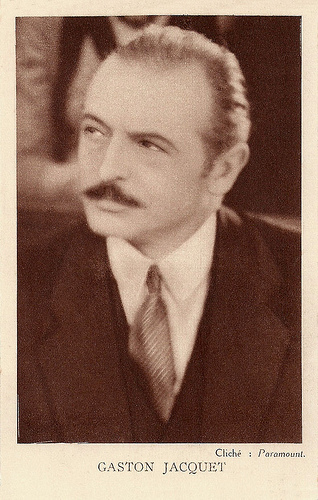
Belgian postcard by NV Cacao en Chocolade, Kivou, Vilvoorde, Belgium. Photo: Paramount. Publicity still for an early French sound film.
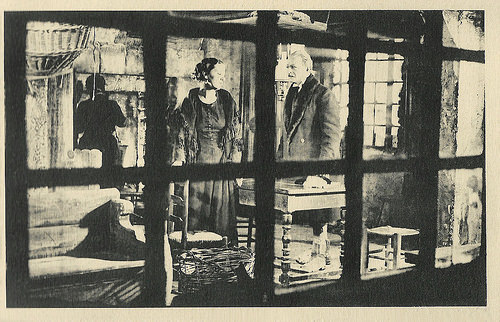
French postcard by Film français Aubert, Paris. Photo: publicity still for Le Tourbillon de Paris/The Maelstrom of Paris (Julien Duvivier, 1928) with Lil Dagover and Gaston Jacquet.
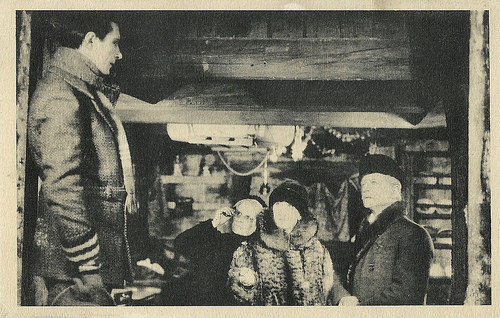
French postcard by Film français Aubert, Paris. Photo: publicity still for Le Tourbillon de Paris/The Maelstrom of Paris (Julien Duvivier, 1928) with Léon Bary, Lil Dagover and Gaston Jacquet.
Scene from Prix de beauté/Beauty Prize (1930). The originally silent film was later dubbed. Source: msatch 1952 (YouTube).
Scene from La fin du jour/The End of the Day (1939). Source: Mr. David Cairns (YouTube).
Sources: James Travers (Films de France), Thomas Staedeli (Cyranos), DB DuMonteil (IMDb), AllMovie, Wikipedia (French) and .

French postcard by Editions Cinématographiques Jacques Haïk, no. 4. Photo: Combier Mâcon. Gaston Jacquet as Le Chevalier Henri de Lagardère in Le Bossu/The Duke's Motto (Jean Kemm, 1925).

Austrian postcard by Iris Verlag, no. 5768. Photo: Verleih Ella Frischauer.

French postcard by Cinémagazine Edition, no. 95.

French postcard by Film français Aubert, Paris. Photo: publicity still for Le Tourbillon de Paris/The Maelstrom of Paris (Julien Duvivier, 1928) with Lil Dagover.
The Three Musketeers
Gaston Jacquet was born as Émile Marius Jacquet in Lanas, France in 1883.
He started his film career with such silent films as Qui a tué?/Who killed? (Pierre Marodon, 1919) with Elmire Vautier , Le sang des immortelles/The blood of the immortals (André Liabel, 1919) with Marcel Vibert , and Celle qui n'a pas dit son nom/The one who did not say her name (Maurice de Marsan, 1919).
In the early 1920s, he played in dozens of films, such as Les femmes des autres/The Wives of Others (Pierre Marodon, 1920) starring Renée Sylvaire , as De Winter in Les trois mousquetaires/The Three Musketeers (Henri Diamant-Berger, 1921) with Aimé Simon-Girard as D’Artagnan, and L'ouragan sur la montagne/The Hurricane on the Mountain (1922), directed by the young Julien Duvivier.
He also starred in Duvivier’s Le reflet de Claude Mercoeur/The Reflection of Claude Mercoeur (Julien Duvivier, 1923) starring Camille Beuve, Coeurs farouches/Wild hearts (Julien Duvivier, 1924) with Rolla Norman , and Credo ou la tragédie de Lourdes/Credo or The Tragedy of Lourdes (Julien Duvivier, 1924).
Their biggest success was the funny extravaganza Le mystère de la tour Eiffel/The Mystery of the Eiffel Tower (Julien Duvivier, 1927) with the boy Jimmy Gaillard , who would become an actor when he grew up.
DB DuMonteil at IMDb about the sole remaining copy in the Dutch Eye Institute: “The best of what remains of the original work is the final scenes, on the Eiffel Tower, where Duvivier already showed he would be one of the greatest French directors of all time. He filmed the famous tower in a way that is almost frightening: the steel frames, the cables, everything creates a new world where men are like spiders on a giant web, while the crowd looks like ants on the Champ De Mars.”
The following year they worked again together at L'agonie de Jérusalem/The Agony of Jerusalem (Julien Duvivier, 1928) and Le tourbillon de Paris/The Maelstrom of Paris (Julien Duvivier, 1928) with German star Lil Dagover .
Jacquet also played supporting parts in German silent films, such as the Anny Ondra comedies Der erste Kuß/The First Kiss (Carl Lamac, 1928) and Saxophon-Susi/Suzy Saxaphone (Carl Lamac, 1928), and in Großstadtschmetterling/Pavement Butterfly (Richard Eichberg, 1929) starring Anna May Wong .
One of his last silent films was Prix de beauté/Beauty Prize (Augusto Genina, 1930) about which James Travers at Films de France writes: “Prix de beauté was one of the last silent masterpieces, directed by Augusto Genina and scripted by René Clair (himself a great director). Released at a time when sound films were becoming the norm, this film was largely overlooked and has only comparatively recently received the attention it deserves. The film stars Louise Brooks in the role of the eponymous tragic femme fatale, a part that suits the beautiful young actress perfectly.”

French postcard by Editions Jacques Haïk. Photo: Combier Mâcon. Publicity still for Le Bossu/The Duke's Motto (Jean Kemm, 1925).

French postcard by Editions Jacques Haïk, no. 5. Photo: Combier Mâcon. Publicity still for Le Bossu/The Duke's Motto (Jean Kemm, 1925). Caption: "Lagardère {à L'Enfant" (Young) Lagardère).

French postcard by Editions Jacques Haïk, no. 13. Photo: Combier Mâcon. Publicity still for Le Bossu/The Duke's Motto (Jean Kemm, 1925). Caption: Lagardère (Gaston Jacquet). 'Les Etablissements Jacques Haïk ont fait tourner pour vous "Le Bossu"... et Lagardère fera tourner toutes les têtes.' (Jacques Haïk company made Le Bossu for you ... and Lagardère will make all heads turn.)

French postcard by Editions Jacques Haïk, no. 120. Photo: Combier Mâcon. Publicity still for Le Bossu/The Duke's Motto (Jean Kemm, 1925).
Old Pal Duvivier
In the sound era, Gaston Jacquet continued to appear in international productions and reunited with Anny Ondra in the German comedy Das Mädel aus U.S.A/The Girl from the USA (Carl Lamac, 1930).
In France he had a supporting part in Le chemin du paradis/The Road To Paradise (Wilhelm Thiele, Max de Vaucorbeil, 1930) starring Lilian Harvey . The latter was the French version of the UFA box office hit Die Drei von der Tankstelle/Three from the Gasoline Station (Wilhelm Thiele, 1930).
Another French version of a popular UFA film was Le vainqueur/The Winner (Hans Hinrich, Paul Martin, 1932) with Jean Murat (the German version was Der Sieger/The Winner (Hans Hinrich, Paul Martin, 1932) with Hans Albers ).
Jacquet reunited with Julien Duvivier for the latter's first sound film, the drama David Golder (1931), and for the George Siménon adaptation La tête d'un homme/A Man's Neck (1933), both starring Harry Baur .
Other interesting films were the comedy Enlevez-moi/Abduct me (Léonce Perret, 1932) with Arletty , and the fantasy film Le golem/The Golem (Julien Duvivier, 1936) starring Harry Baur .
He also played a small part in Duvivier’s masterpiece La fin du jour/The End of the Day (Julien Duvivier, 1939), starring Victor Francen , Michel Simon and Louis Jouvet as three old and penniless actors living in a near bankrupt retirement home.
DB DuMonteil at IMDb thinks it is “Probably Duvivier's pre-war peak. His pessimism reaches here such unbelievable heights that we're brooding all along the movie and long after having seen it.”
From then on Jacquet’s film appearances became smaller and more incidental. He was seen in such films as Jeunes filles en détresse/Girls in Distress (Georg Wilhelm Pabst, 1939) with Micheline Presle in one of her first roles, and La neige sur les pas/The snow on the steps (André Berthomieu, 1942) starring Pierre Blanchar .
His final film appearance followed 15 years later. It was a small part in another film by his old pal Duvivier, Pot-bouille/Lovers of Paris (Julien Duvivier, 1957) starring Gérard Philipe .
Gaston Jacquet died in 1970 in Thonex, Switzerland.

Belgian postcard by NV Cacao en Chocolade, Kivou, Vilvoorde, Belgium. Photo: Paramount. Publicity still for an early French sound film.

French postcard by Film français Aubert, Paris. Photo: publicity still for Le Tourbillon de Paris/The Maelstrom of Paris (Julien Duvivier, 1928) with Lil Dagover and Gaston Jacquet.

French postcard by Film français Aubert, Paris. Photo: publicity still for Le Tourbillon de Paris/The Maelstrom of Paris (Julien Duvivier, 1928) with Léon Bary, Lil Dagover and Gaston Jacquet.
Scene from Prix de beauté/Beauty Prize (1930). The originally silent film was later dubbed. Source: msatch 1952 (YouTube).
Scene from La fin du jour/The End of the Day (1939). Source: Mr. David Cairns (YouTube).
Sources: James Travers (Films de France), Thomas Staedeli (Cyranos), DB DuMonteil (IMDb), AllMovie, Wikipedia (French) and .
Published on July 05, 2018 22:00
July 4, 2018
Vingt ans après (1922)
The silent French film serial Vingt ans après/The Return of the Musketeers (1922) is the sequel to Les Trois Mousquetaires/The Three Musketeers (1921), one of the first film versions of Alexandre Dumas père's famous novel. The sequel literally plays twenty years later after Les Trois Mousquetaires. Both film versions were directed by Henri Diamant-Berger. And as they did for the film adaptation of Les Trois Mousquetaires, Cinémagazine and Pathé produced a beautiful series of sepia portrait postcards especially for Vingt ans après.

French postcard. Photo: Pathé. Publicity still for Vingt ans après/The Return of the Musketeers (Henri Diamant-Berger, 1922). Athos ( Henri Rollan ) and his son Raoul, played by actress Pierrette Madd .
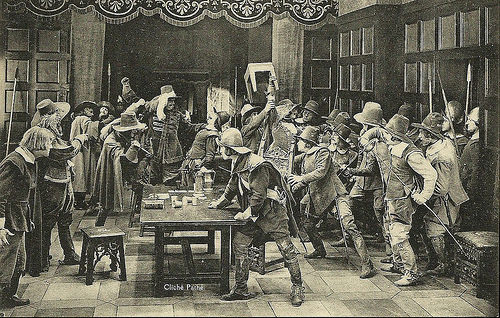
French postcard. Photo: Pathé. Publicity still for Vingt ans après/The Return of the Musketeers (Henri Diamant-Berger, 1922). Collection: Didier Hanson.

French postcard. Photo: Pathé. Publicity still for Vingt ans après/The Return of the Musketeers (Henri Diamant-Berger, 1922). Collection: Didier Hanson.
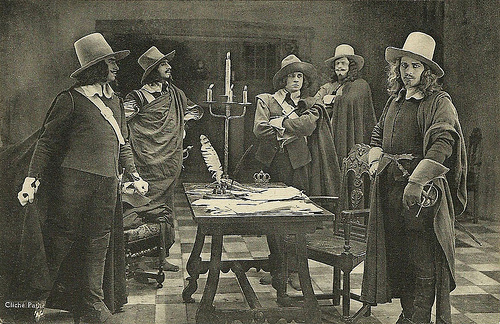
French postcard. Photo: Pathé. Publicity still for Vingt ans après/The Return of the Musketeers (Henri Diamant-Berger, 1922). Collection: Didier Hanson.
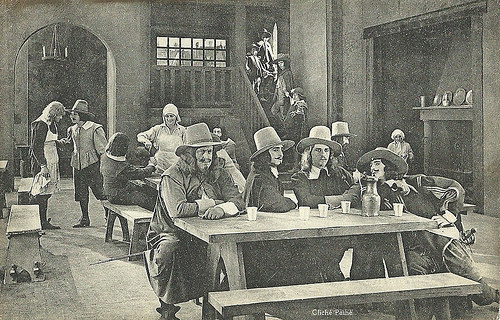
French postcard. Photo: Pathé. Publicity still for Vingt ans après/The Return of the Musketeers (Henri Diamant-Berger, 1922). The four musketeers Porthos ( Charles Martinelli ), Aramis ( Pierre de Guingand ), Athos ( Henri Rollan ), and D'Artagnan (Jean Yonnel).
Alexandre Dumas
Vingt ans après literally translates as Twenty Years After, but abroad the film was also known as The Return of the Three Musketeers. It was a sequel to the successful Pathé serial Les Trois Mousquetaires/The Three Musketeers (Henri Diamant-Berger, 1921), which had been only the second adaptation of the famous adventure novel by Alexandre Dumas père, published in 1844.
Vingt ans après/The Return of the Musketeers (Henri Diamant-Berger, 1922) was also based on a novel by Alexandre Dumas père. Dumas first serialised Vingt ans après from January to August 1845. His novel follows events in France during the Fronde, during the childhood reign of Louis XIV, and in England near the end of the English Civil War, leading up to the victory of Oliver Cromwell and the execution of King Charles I.
Through the words of the main characters, particularly Athos, Dumas comes out on the side of the monarchy in general, or at least the text often praises the idea of benevolent royalty. His musketeers are valiant and just in their efforts to protect young Louis XIV and the doomed Charles I from their attackers.
Vingt ans après precedes another novel, The Vicomte of Bragelonne: Ten Years Later (Le Vicomte de Bragelonne ou Dix ans plus tard), which appeared first in serial form between 1847 and 1850.
It includes the subplot The Man in the Iron Mask about the fictive twin brother of Louis XIV, Philippe, who had been concealed and imprisoned from birth by his father, Louis XIII, and his mother, Anne of Austria, 'for the good of France'.
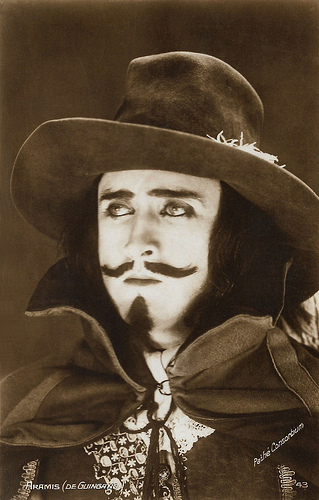
Pierre de Guingand as Aramis. French postcard by Cinémagazine Edition no. 43. Photo: Pathé Consortium Cinéma. Publicity still for Vingt Ans Après (1922).
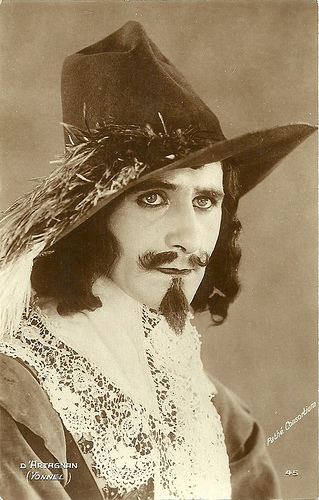
Jean Yonnel as D'Artagnan. French postcard by Editions Cinémagazine Edition, no. 45. Photo: Pathé Consortium Cinéma. Publicity still for Vingt Ans Après (1922).
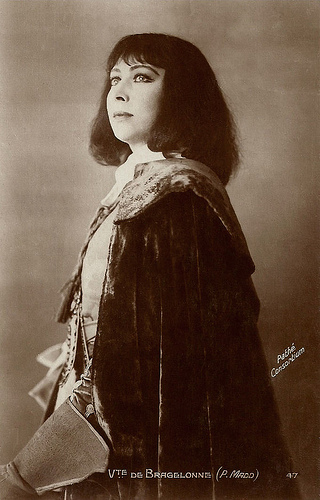
Pierrette Madd as Raoul, the Vicomte de Bragelonne. French postcard by Cinémagazine Edition no. 47. Photo: Pathé Consortium Cinéma. Publicity still for Vingt Ans Après (1922).
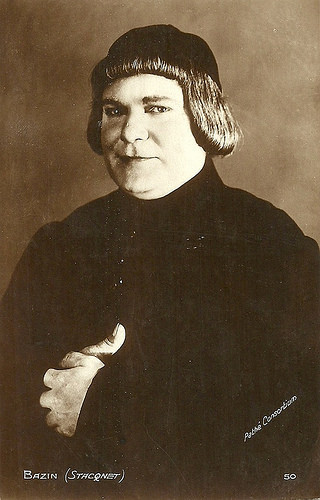
Antoine Stacquet as Bazin, one of the aids of the musketeers. French postcard by Cinémagazine Edition, no. 50. Photo: Pathé Consortium Cinéma. Publicity still for Vingt Ans Après (1922).
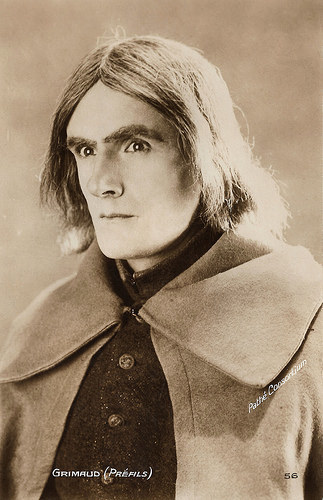
Louis Pré Fils as Grimaud. French postcard by Editions Cinémagazine no. 56. Photo: Pathé Consortium Cinéma. Publicity still for Vingt ans après (1922).
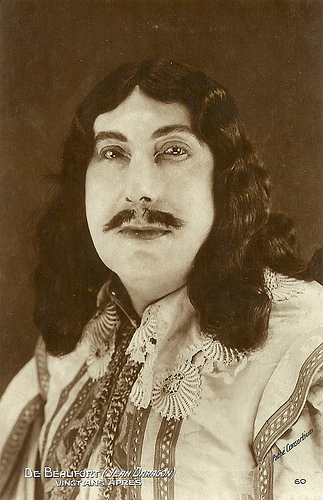
Jean Daragon as De Beaufort. French postcard by Cinémagazine Edition, no. 60. Photo: Pathé Consortium Cinéma. Publicity still for Vingt Ans Après (1922).
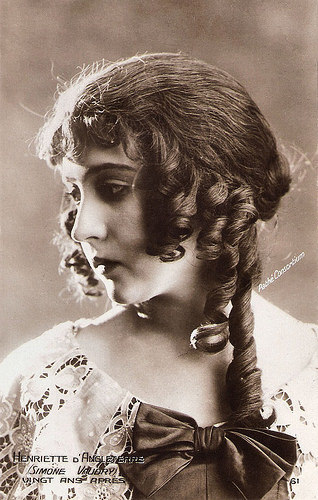
Simone Vaudry as Henriette d'Angleterre. French postcard by Cinémagazine Edition, no. 61. Photo: Pathé Consortium Cinéma. Publicity still for Vingt Ans Après (1922).
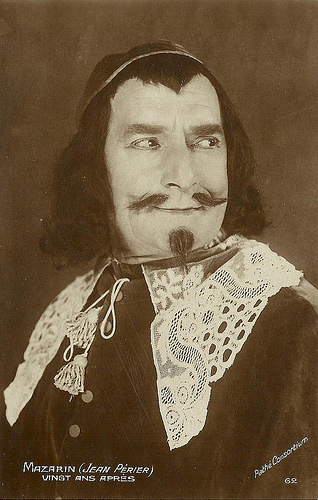
Jean Périer as Cardinal Mazarin. French postcard by Cinémagazine Edition, no. 62. Photo: Pathé Consortium Cinéma. Publicity still for Vingt Ans Après (1922). Collection: Didier Hanson.
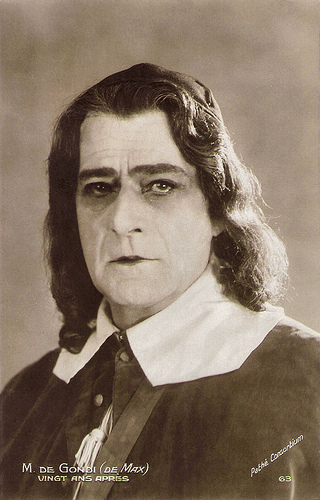
Édouard de Max as Monsieur de Gondi. French postcard by Cinémagazine Edition, no. 63. Photo: Pathé Consortium Cinéma. Publicity still for Vingt Ans Après (1922).
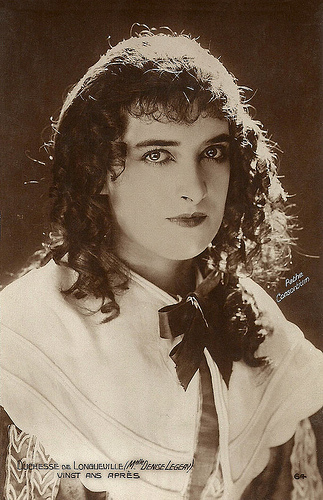
Denise Legeay as The Duchess of Longueville. French postcard by Cinémagazine Edition, no. 64. Photo: Pathé Consortium Cinéma. Publicity still for Vingt Ans Après (1922).
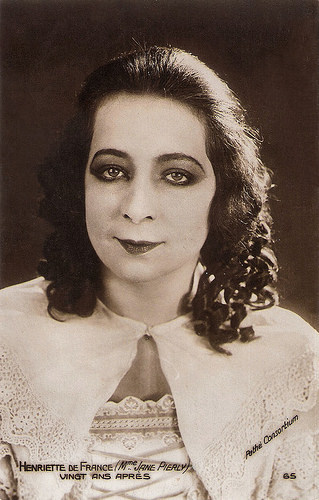
Jane Piérly as Henriette de France. French postcard by Editions Cinémagazine no. 65. Photo: Pathé Consortium Cinéma. Publicity still for Vingt ans après (1922).
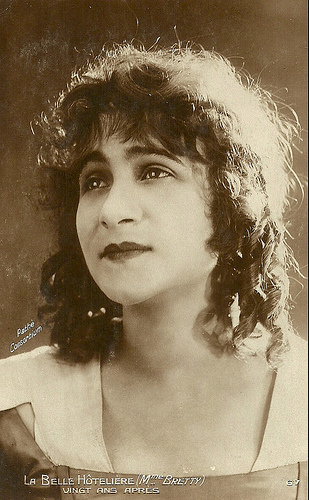
Béatrice Bretty as La Belle Hôtelière. French postcard by Cinémagazine Edition, no. 67. Photo: Pathé Consortium. Publicity still for Vingt ans après/The Return of the Musketeers (Henri Diamant-Berger, 1922).
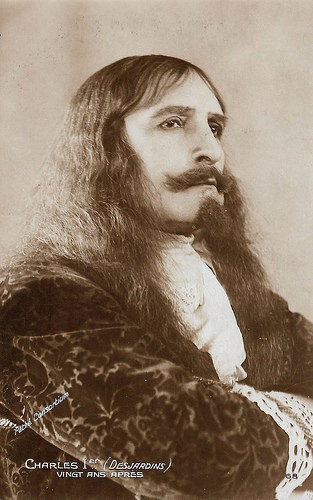
Maxime Desjardins as the English King Charles I. French postcard by Cinémagazine Edition, no. 68. Photo: Pathé Consortium. Publicity still for Vingt ans après/The Return of the Musketeers (Henri Diamant-Berger, 1922).
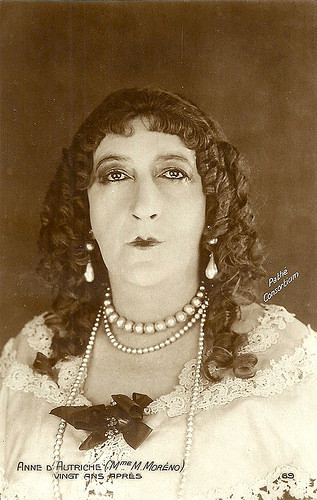
Marguerite Moreno as Queen Anne of Austria, widow of King Charles XIII. French postcard by Cinémagazine Edition, no. 69. Photo: Pathé Consortium. Publicity still for Vingt ans après/The Return of the Musketeers (Henri Diamant-Berger, 1922).
The last reunion of the Four Musketeers
The film version of Vingt ans après/The Return of the Musketeers (1922) starts under Queen Anne of Austria regency and Cardinal Mazarin ruling. D'Artagnan, who seemed to have a promising career ahead of him at the end of The Three Musketeers, has for twenty years remained a lieutenant in the Musketeers. He seems unlikely to progress, despite his ambition and the debt the queen owes him.
By chance, however, he is summoned by Cardinal Mazarin ( Jean Périer ), who requires an escort, as the French people detest Mazarin, and are on the brink of rebellion (La Fronde).
D'Artagnan is sent to the Bastille to retrieve a prisoner, who turns out to be his former adversary, the Comte de Rochefort. But De Rochefort escapes. D'Artagnan goes searching for his old friends, and the four musketeers are reunited for one more time.
Pathé Frères again produced the film and Henri Diamant-Berger returned as director. D'Artagnan was not played by Aimé Simon-Girard this time. Jean Yonnel replaced him.
The other three musketeers of the original cast returned: Henri Rollan as Athos, Pierre de Guingand as Aramis and Charles Martinelli as Porthos. Other actors who returned were Édouard de Max (Richelieu) and Armand Bernard (D'Artagnan's servant Planchet).
They were joined in Vingt ans après by Marguerite Moreno as Anne of Austria, Jean Périer as Mazarin, Simone Vaudry as Henriette d'Angleterre, and Béatrice Bretty as a beautiful in-keeper.
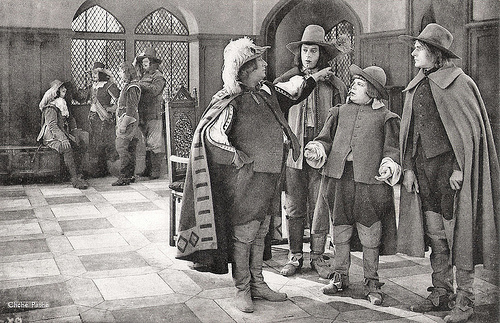
French postcard. Photo: Pathé. Publicity still for Vingt ans après/The Return of the Musketeers (Henri Diamant-Berger, 1922). Right front, small Antoine Stacquet as Bazin and tall Louis Pré Fils as Grimaud. Left in the back the three musketeers and D'Artagnan.
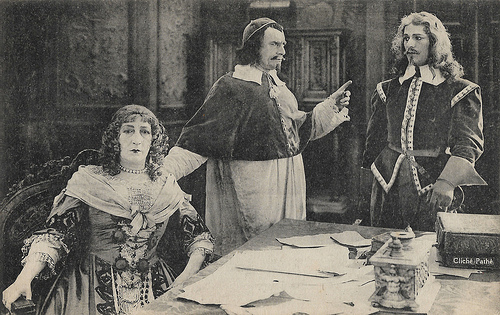
French postcard. Photo: Pathé. Publicity still for Vingt ans après/The Return of the Musketeers (Henri Diamant-Berger, 1922). Marguerite Moreno as Queen-Mother Anne of Austria, Jean Périer as Cardinal Mazarin, and Henri Rollan as Athos.
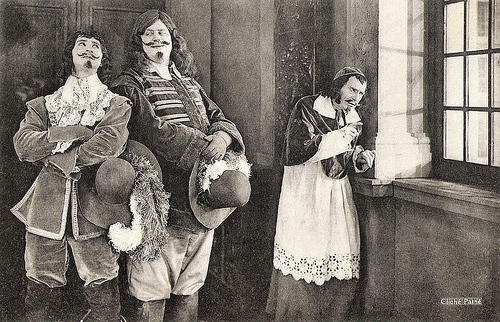
French postcard. Photo: Pathé. Publicity still for Vingt ans après/The Return of the Musketeers (Henri Diamant-Berger, 1922). Jean Yonnel as D'Artagnan, Charles Martinelli as Porthos, and Jean Périer as Cardinal Mazarin.
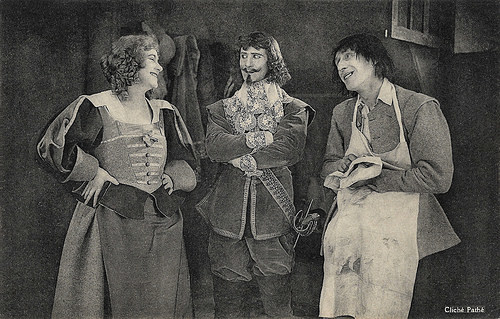
French postcard. Photo: Pathé. Publicity still for Vingt ans après/The Return of the Musketeers (Henri Diamant-Berger, 1922). Pictured are (possibly) Béatrice Bretty as La Belle Hôtelière, Jean Yonnel as D'Artagnan, and Armand Bernard as Planchet.
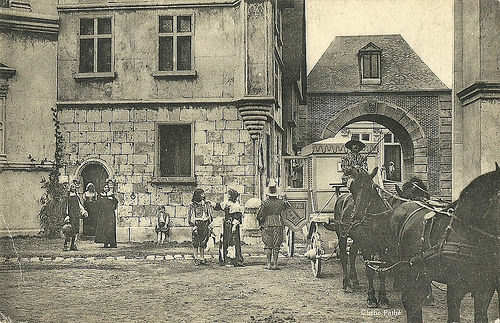
French postcard. Photo: Pathé. Publicity still for Vingt ans après/The Return of the Musketeers (Henri Diamant-Berger, 1922). The girl dressed up a boy is Pierrette Madd (Vicomte de Bragelonne).
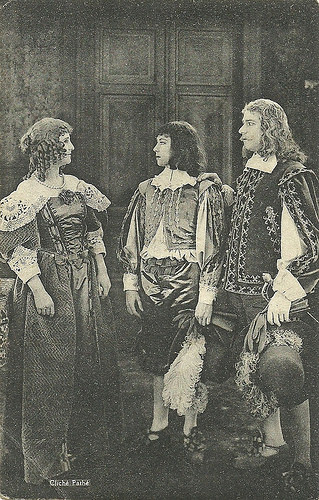
French postcard. French postcard. Photo: Pathé. Publicity still for Vingt ans après/The Return of the Musketeers (Henri Diamant-Berger, 1922). Athos presents his son, the Vicomte de Bragelonne, to the Queen.
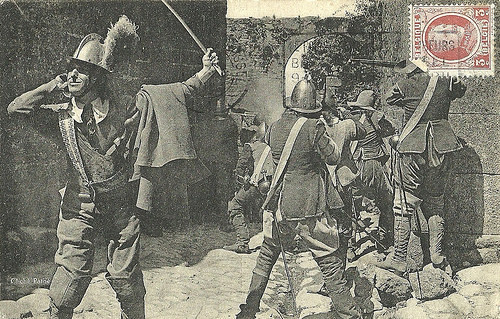
French postcard. Photo: Pathé. Publicity still for Vingt ans après/The Return of the Musketeers (Henri Diamant-Berger, 1922). Cromwellian soldiers in battle. This card made publicity on the retro for the screening of this film at the Pathé-Palace cinema in Brussels, Bd. Anspach, where it first ran 12-18 January 1923.
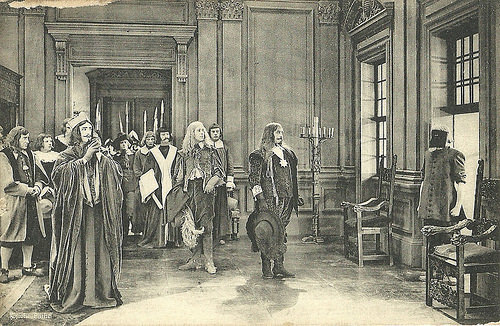
French postcard. French postcard. Photo: Pathé. Publicity still for Vingt ans après/The Return of the Musketeers (Henri Diamant-Berger, 1922). The henchman collecting Charles I.
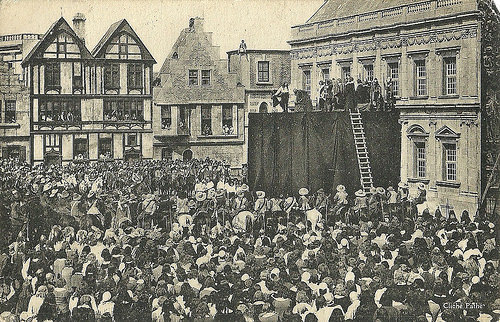
French postcard. French postcard. Photo: Pathé. Publicity still for Vingt ans après/The Return of the Musketeers (Henri Diamant-Berger, 1922). The execution of king Charles I on 30 January 1649 in London.
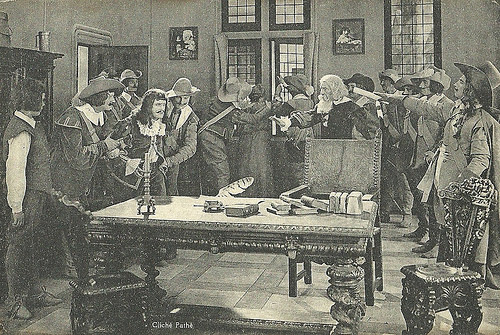
French postcard. French postcard. Photo: Pathé. Publicity still for Vingt ans après/The Return of the Musketeers (Henri Diamant-Berger, 1922).
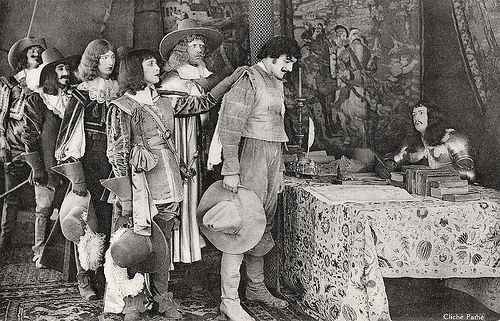
French postcard. Photo: Pathé. Publicity still for Vingt ans après/The Return of the Musketeers (Henri Diamant-Berger, 1922). The woman dressed up as a man in the middle is ; Pierrette Madd , who plays the Vicomte de Bragelonne, son of Athos.
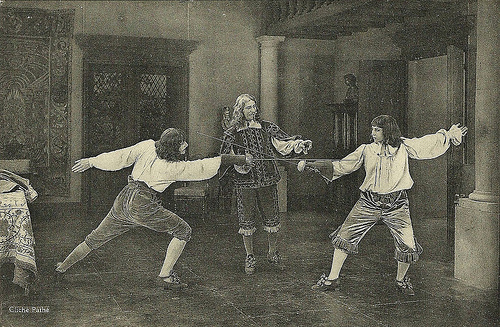
French postcard. Photo: Pathé. Publicity still for Vingt ans après/The Return of the Musketeers (Henri Diamant-Berger, 1922). Collection: Didier Hanson.
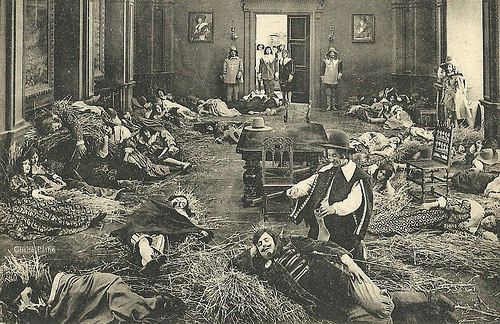
French postcard. French postcard. Photo: Pathé. Publicity still for Vingt ans après/The Return of the Musketeers (Henri Diamant-Berger, 1922). Porthos and Planchet [?].
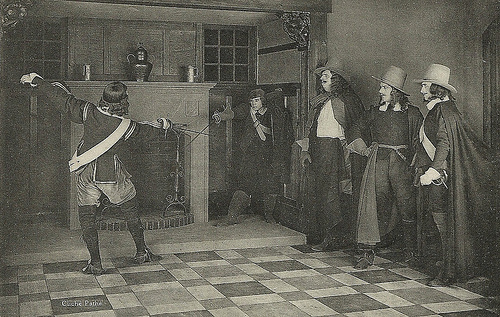
French postcard. Photo: Pathé. Publicity still for Vingt ans après/The Return of the Musketeers (Henri Diamant-Berger, 1922). Collection: Didier Hanson.
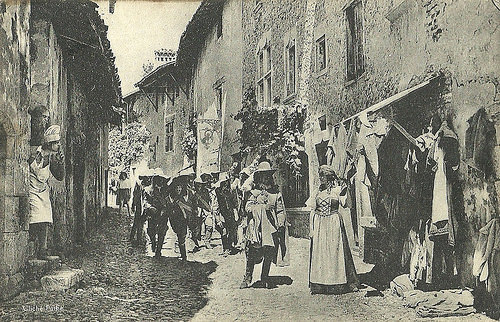
French postcard. French postcard. Photo: Pathé. Publicity still for Vingt ans après/The Return of the Musketeers (Henri Diamant-Berger, 1922).
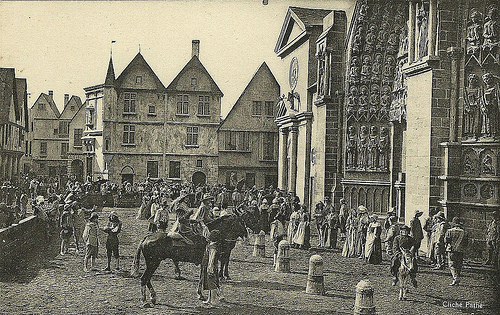
French postcard. Photo: Pathé. Publicity still for Vingt ans après/The Return of the Musketeers (Henri Diamant-Berger, 1922). Collection: Didier Hanson.
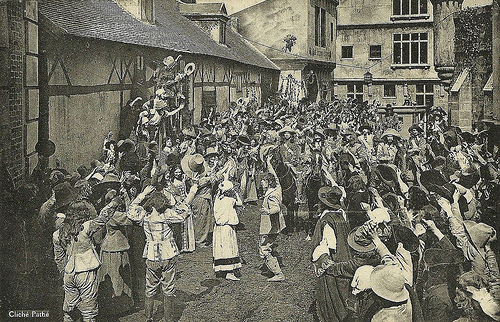
French postcard. Photo: Pathé. Publicity still for Vingt ans après/The Return of the Musketeers (Henri Diamant-Berger, 1922). Collection: Didier Hanson.
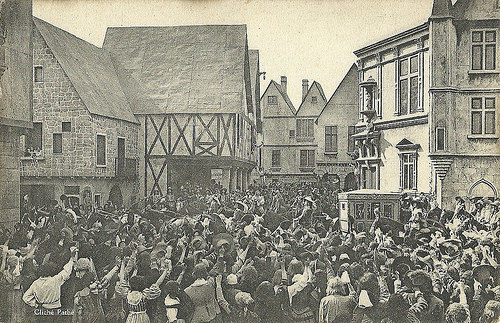
French postcard. Photo: Pathé. Publicity still for Vingt ans après/The Return of the Musketeers (Henri Diamant-Berger, 1922).
Sources: Wikipedia and IMDb.

French postcard. Photo: Pathé. Publicity still for Vingt ans après/The Return of the Musketeers (Henri Diamant-Berger, 1922). Athos ( Henri Rollan ) and his son Raoul, played by actress Pierrette Madd .

French postcard. Photo: Pathé. Publicity still for Vingt ans après/The Return of the Musketeers (Henri Diamant-Berger, 1922). Collection: Didier Hanson.

French postcard. Photo: Pathé. Publicity still for Vingt ans après/The Return of the Musketeers (Henri Diamant-Berger, 1922). Collection: Didier Hanson.

French postcard. Photo: Pathé. Publicity still for Vingt ans après/The Return of the Musketeers (Henri Diamant-Berger, 1922). Collection: Didier Hanson.

French postcard. Photo: Pathé. Publicity still for Vingt ans après/The Return of the Musketeers (Henri Diamant-Berger, 1922). The four musketeers Porthos ( Charles Martinelli ), Aramis ( Pierre de Guingand ), Athos ( Henri Rollan ), and D'Artagnan (Jean Yonnel).
Alexandre Dumas
Vingt ans après literally translates as Twenty Years After, but abroad the film was also known as The Return of the Three Musketeers. It was a sequel to the successful Pathé serial Les Trois Mousquetaires/The Three Musketeers (Henri Diamant-Berger, 1921), which had been only the second adaptation of the famous adventure novel by Alexandre Dumas père, published in 1844.
Vingt ans après/The Return of the Musketeers (Henri Diamant-Berger, 1922) was also based on a novel by Alexandre Dumas père. Dumas first serialised Vingt ans après from January to August 1845. His novel follows events in France during the Fronde, during the childhood reign of Louis XIV, and in England near the end of the English Civil War, leading up to the victory of Oliver Cromwell and the execution of King Charles I.
Through the words of the main characters, particularly Athos, Dumas comes out on the side of the monarchy in general, or at least the text often praises the idea of benevolent royalty. His musketeers are valiant and just in their efforts to protect young Louis XIV and the doomed Charles I from their attackers.
Vingt ans après precedes another novel, The Vicomte of Bragelonne: Ten Years Later (Le Vicomte de Bragelonne ou Dix ans plus tard), which appeared first in serial form between 1847 and 1850.
It includes the subplot The Man in the Iron Mask about the fictive twin brother of Louis XIV, Philippe, who had been concealed and imprisoned from birth by his father, Louis XIII, and his mother, Anne of Austria, 'for the good of France'.

Pierre de Guingand as Aramis. French postcard by Cinémagazine Edition no. 43. Photo: Pathé Consortium Cinéma. Publicity still for Vingt Ans Après (1922).

Jean Yonnel as D'Artagnan. French postcard by Editions Cinémagazine Edition, no. 45. Photo: Pathé Consortium Cinéma. Publicity still for Vingt Ans Après (1922).

Pierrette Madd as Raoul, the Vicomte de Bragelonne. French postcard by Cinémagazine Edition no. 47. Photo: Pathé Consortium Cinéma. Publicity still for Vingt Ans Après (1922).

Antoine Stacquet as Bazin, one of the aids of the musketeers. French postcard by Cinémagazine Edition, no. 50. Photo: Pathé Consortium Cinéma. Publicity still for Vingt Ans Après (1922).

Louis Pré Fils as Grimaud. French postcard by Editions Cinémagazine no. 56. Photo: Pathé Consortium Cinéma. Publicity still for Vingt ans après (1922).

Jean Daragon as De Beaufort. French postcard by Cinémagazine Edition, no. 60. Photo: Pathé Consortium Cinéma. Publicity still for Vingt Ans Après (1922).

Simone Vaudry as Henriette d'Angleterre. French postcard by Cinémagazine Edition, no. 61. Photo: Pathé Consortium Cinéma. Publicity still for Vingt Ans Après (1922).

Jean Périer as Cardinal Mazarin. French postcard by Cinémagazine Edition, no. 62. Photo: Pathé Consortium Cinéma. Publicity still for Vingt Ans Après (1922). Collection: Didier Hanson.

Édouard de Max as Monsieur de Gondi. French postcard by Cinémagazine Edition, no. 63. Photo: Pathé Consortium Cinéma. Publicity still for Vingt Ans Après (1922).

Denise Legeay as The Duchess of Longueville. French postcard by Cinémagazine Edition, no. 64. Photo: Pathé Consortium Cinéma. Publicity still for Vingt Ans Après (1922).

Jane Piérly as Henriette de France. French postcard by Editions Cinémagazine no. 65. Photo: Pathé Consortium Cinéma. Publicity still for Vingt ans après (1922).

Béatrice Bretty as La Belle Hôtelière. French postcard by Cinémagazine Edition, no. 67. Photo: Pathé Consortium. Publicity still for Vingt ans après/The Return of the Musketeers (Henri Diamant-Berger, 1922).

Maxime Desjardins as the English King Charles I. French postcard by Cinémagazine Edition, no. 68. Photo: Pathé Consortium. Publicity still for Vingt ans après/The Return of the Musketeers (Henri Diamant-Berger, 1922).

Marguerite Moreno as Queen Anne of Austria, widow of King Charles XIII. French postcard by Cinémagazine Edition, no. 69. Photo: Pathé Consortium. Publicity still for Vingt ans après/The Return of the Musketeers (Henri Diamant-Berger, 1922).
The last reunion of the Four Musketeers
The film version of Vingt ans après/The Return of the Musketeers (1922) starts under Queen Anne of Austria regency and Cardinal Mazarin ruling. D'Artagnan, who seemed to have a promising career ahead of him at the end of The Three Musketeers, has for twenty years remained a lieutenant in the Musketeers. He seems unlikely to progress, despite his ambition and the debt the queen owes him.
By chance, however, he is summoned by Cardinal Mazarin ( Jean Périer ), who requires an escort, as the French people detest Mazarin, and are on the brink of rebellion (La Fronde).
D'Artagnan is sent to the Bastille to retrieve a prisoner, who turns out to be his former adversary, the Comte de Rochefort. But De Rochefort escapes. D'Artagnan goes searching for his old friends, and the four musketeers are reunited for one more time.
Pathé Frères again produced the film and Henri Diamant-Berger returned as director. D'Artagnan was not played by Aimé Simon-Girard this time. Jean Yonnel replaced him.
The other three musketeers of the original cast returned: Henri Rollan as Athos, Pierre de Guingand as Aramis and Charles Martinelli as Porthos. Other actors who returned were Édouard de Max (Richelieu) and Armand Bernard (D'Artagnan's servant Planchet).
They were joined in Vingt ans après by Marguerite Moreno as Anne of Austria, Jean Périer as Mazarin, Simone Vaudry as Henriette d'Angleterre, and Béatrice Bretty as a beautiful in-keeper.

French postcard. Photo: Pathé. Publicity still for Vingt ans après/The Return of the Musketeers (Henri Diamant-Berger, 1922). Right front, small Antoine Stacquet as Bazin and tall Louis Pré Fils as Grimaud. Left in the back the three musketeers and D'Artagnan.

French postcard. Photo: Pathé. Publicity still for Vingt ans après/The Return of the Musketeers (Henri Diamant-Berger, 1922). Marguerite Moreno as Queen-Mother Anne of Austria, Jean Périer as Cardinal Mazarin, and Henri Rollan as Athos.

French postcard. Photo: Pathé. Publicity still for Vingt ans après/The Return of the Musketeers (Henri Diamant-Berger, 1922). Jean Yonnel as D'Artagnan, Charles Martinelli as Porthos, and Jean Périer as Cardinal Mazarin.

French postcard. Photo: Pathé. Publicity still for Vingt ans après/The Return of the Musketeers (Henri Diamant-Berger, 1922). Pictured are (possibly) Béatrice Bretty as La Belle Hôtelière, Jean Yonnel as D'Artagnan, and Armand Bernard as Planchet.

French postcard. Photo: Pathé. Publicity still for Vingt ans après/The Return of the Musketeers (Henri Diamant-Berger, 1922). The girl dressed up a boy is Pierrette Madd (Vicomte de Bragelonne).

French postcard. French postcard. Photo: Pathé. Publicity still for Vingt ans après/The Return of the Musketeers (Henri Diamant-Berger, 1922). Athos presents his son, the Vicomte de Bragelonne, to the Queen.

French postcard. Photo: Pathé. Publicity still for Vingt ans après/The Return of the Musketeers (Henri Diamant-Berger, 1922). Cromwellian soldiers in battle. This card made publicity on the retro for the screening of this film at the Pathé-Palace cinema in Brussels, Bd. Anspach, where it first ran 12-18 January 1923.

French postcard. French postcard. Photo: Pathé. Publicity still for Vingt ans après/The Return of the Musketeers (Henri Diamant-Berger, 1922). The henchman collecting Charles I.

French postcard. French postcard. Photo: Pathé. Publicity still for Vingt ans après/The Return of the Musketeers (Henri Diamant-Berger, 1922). The execution of king Charles I on 30 January 1649 in London.

French postcard. French postcard. Photo: Pathé. Publicity still for Vingt ans après/The Return of the Musketeers (Henri Diamant-Berger, 1922).

French postcard. Photo: Pathé. Publicity still for Vingt ans après/The Return of the Musketeers (Henri Diamant-Berger, 1922). The woman dressed up as a man in the middle is ; Pierrette Madd , who plays the Vicomte de Bragelonne, son of Athos.

French postcard. Photo: Pathé. Publicity still for Vingt ans après/The Return of the Musketeers (Henri Diamant-Berger, 1922). Collection: Didier Hanson.

French postcard. French postcard. Photo: Pathé. Publicity still for Vingt ans après/The Return of the Musketeers (Henri Diamant-Berger, 1922). Porthos and Planchet [?].

French postcard. Photo: Pathé. Publicity still for Vingt ans après/The Return of the Musketeers (Henri Diamant-Berger, 1922). Collection: Didier Hanson.

French postcard. French postcard. Photo: Pathé. Publicity still for Vingt ans après/The Return of the Musketeers (Henri Diamant-Berger, 1922).

French postcard. Photo: Pathé. Publicity still for Vingt ans après/The Return of the Musketeers (Henri Diamant-Berger, 1922). Collection: Didier Hanson.

French postcard. Photo: Pathé. Publicity still for Vingt ans après/The Return of the Musketeers (Henri Diamant-Berger, 1922). Collection: Didier Hanson.

French postcard. Photo: Pathé. Publicity still for Vingt ans après/The Return of the Musketeers (Henri Diamant-Berger, 1922).
Sources: Wikipedia and IMDb.
Published on July 04, 2018 22:00
July 3, 2018
Jean Périer
French operatic baritone and actor Jean Périer (1869-1954) had a long association with the Opéra-Comique in Paris. Although he sang principally within the operetta repertoire, Périer portrayed roles in operas by Mozart and Puccini, and he originated the role of Pelléas in Debussy's Pelléas et Mélisande in 1902. Périer also appeared over 30 films between 1910 and 1948 and he played Cardinal Mazarin in the serial Vingt Ans Après/The Return of the Musketeers (Henri Diamant-Berger, 1922) based on a novel by Alexandre Dumas Père.

French postcard by Cinémagazine Edition, no. 62. Photo: Pathé Consortium Cinéma. Publicity still for Vingt Ans Après/The Return of the Musketeers with Jean Périer as Mazarin. Collection: Didier Hanson.
Numerous World Premieres
Jean Alexis Périer was born in Paris in 1869. He was the son of Belgian parents. His father was an opera singer and repetiteur. His older brother was the popular singer Camille Périer ‘Kam-Hill’.
After initially working at the Credit Lyonnais bank, he became a pupil of Émile-Alexandre Taskin (opéra comique) and Romain Bussine (singing) at the Paris Conservatoire, winning first prizes in both in 1892.
He made his debut as Monostatos in Wolfgang Amadeus Mozart's The Magic Flute at the Opéra-Comique later that year. He continued to perform at that opera house until 1920, with the exception of the years 1894 through 1900 when he principally sang at the Théâtre des Bouffes Parisiens and other Parisian theatres specialising in operetta.
Although he performed in a many operettas, he also sang a number of operatic roles including the title role in Don Giovanni, Lescaut in Manon Lescaut, and Scarpia in Tosca. His career was almost entirely centred in Paris, particularly at the Opéra-Comique, where he notably created the role of Pelléas in Claude Debussy's Pelléas et Mélisande. He repeated the role of Pelléas at the Manhattan Opera Company in 1908 and at the Opéra de Monte-Carlo.
Périer appeared in numerous other world premieres, most notably Ramiro in Maurice Ravel's L'heure espagnole (1911) and leading roles in Andre Messager's Véronique (1898) and Fortunio (1907).
Périer also played the speaking role of Brother Dominic in the premiere of Arthur Honegger's dramatic oratorio Jeanne d'Arc au Bûcher (Joan of Arc at the Stake) in Basle in 1938, with Ida Rubinstein.
Although described as a baritone, he created roles for Debussy and Ravel in the Baryton-Martin register (light baritone). His was a declamatory art, and he created convincing characters with the help of his clear diction and his ability as an actor.

French postcard. Photo: Pathé. Publicity still for Vingt ans après/The Return of the Musketeers (Henri Diamant-Berger, 1922). Marguerite Moreno as Queen-Mother Anne of Austria, Jean Périer as Cardinal Mazarin, and Henri Rollan as Athos.
Dry and Husky Voice
In addition to his opera career, Jean Périer acted in several films between 1900 and 1938. His first film appearances were in silent shorts, produced by the Pathé Frères: Monsieur Don Quichotte (1910) with Pierre Magnier, L'enfance d'Oliver Twist/Oliver Twist (Camille de Morlhon, 1910), and Manon (1910) featuring Marthe Regnier and based on the novel by Abbé Prevost.
More than ten years later he played Cardinal Mazarin in the 10-part serial Vingt Ans Après (Henri Diamant-Berger, 1922) with Pierre de Guingand . It is a sequel to Les Trois Mousquetaires/The Three Musketeers (Henri Diamant-Berger, 1921) and also based on a novel by Alexandre Dumas Père. His last silent film was Poker d'as/Four Aces (Henri Desfontaines, 1927) starring René Navarre .
Périer had a dry and husky voice which did well in the sound cinema. His sound debut was as a judge in the crime film Autour d'une enquête/Inquest (Henri Chomette, Robert Siodmak, 1931) with Annabella . It was one of the many alternate language versions of German films, in this case the UFA production Voruntersuchung/Inquest (Robert Siodmak, 1931).
In the following years, many film roles followed, like in the Paramount production Simone est comme ça/Simone is like that (Karl Anton, 1932) with Meg Lemonnier , La belle aventure/The Beautiful Adventure (Roger Le Bon, Reinhold Schünzel , 1932) with Käthe von Nagy , and Roi de Camargue/King of the Camargue (Jacques de Baroncelli, 1934) with Charles Vanel .
In Pasteur (Sacha Guitry, 1935) he played a doctor opposite director Sacha Guitry himself in the title role. James Travers at Films de France : “ Sacha Guitry ’s first sound film is as much a tribute to his father, Lucien Guitry , as to the great French scientist Louis Pasteur. The film is closely based on a stage play which Lucien Guitry wrote and took the lead role in during the 1920s.
In playing the character of Pasteur in his film, Sacha Guitry is reputed to have modelled his performance on that of his father (who died in 1925), to preserve the memory of his father’s performance. Guitry also wrote a powerful script for the film, which consists mainly of long monologues and – most unusually – includes no female characters”.

French postcard. Photo: Pathé. Publicity still for Vingt ans après/The Return of the Musketeers (Henri Diamant-Berger, 1922). Jean Yonnel as D'Artagnan, Charles Martinelli as Porthos, and Jean Périer as Cardinal Mazarin.
Sacha Guitry
Jean Périer played a lord in the mystery Mister Flow (Robert Siodmak, 1936) featuring Louis Jouvet , and another lord in the Oscar Wilde adaptation Une femme sans importance/A Woman of No Importance (Jean Choux, 1937).
He reunited with Sacha Guitry for the historical comedy Remontons les Champs-Élysées/Champs-Elysees (Sacha Guitry, 1938). After retiring as an opera singer in 1938, Périer worked on as an acting and singing teacher in Paris and also continued to appear in supporting roles in films.
He played a president in the musical Les trois valses/Three Waltzes (Ludwig Berger, 1938) starring Yvonne Printemps , and also in the Johann Wolfgang Goethe adaptation Le roman de Werther/Werther (Max Ophüls, 1938) with Pierre Richard-Willm in the title role, and in the propaganda film Entente cordiale/Cordial agreement (Marcel L’Herbier, 1939) starring Gaby Morlay as Queen Victoria.
He also played Count Charles Talleyrand twice: in the lavish historical drama Le destin fabuleux de Désirée Clary/Mlle. Desiree (Sacha Guitry, 1942) starring Guitry himself as Napoléon, and in Un seul amour/A single love (Pierre Blanchar, 1943) based on a novel by Honoré de Balzac.
After the war he appeared in two more films: the mystic drama La septième porte/The Seventh Door (André Zwoboda, 1948) starring Georges Marchal , and finally he was one more time reunited with Sacha Guitry for Le comédien/The Private Life of an Actor (Sacha Guitry, 1948) in which he played himself.
In 1954, Jean Périer died in Neuilly-sur-Seine, Paris. He was 85.
Reconstruction of the stage play Une étoile nouvelle/A New Star (1924) by and with Sacha Guitry . Source: ben77114gaut (YouTube).
Tomorrow: Vingt ans après/The Return of the Musketeers (Henri Diamant-Berger, 1922).
Sources: James Travers (Films de France), Wikipedia, and .

French postcard by Cinémagazine Edition, no. 62. Photo: Pathé Consortium Cinéma. Publicity still for Vingt Ans Après/The Return of the Musketeers with Jean Périer as Mazarin. Collection: Didier Hanson.
Numerous World Premieres
Jean Alexis Périer was born in Paris in 1869. He was the son of Belgian parents. His father was an opera singer and repetiteur. His older brother was the popular singer Camille Périer ‘Kam-Hill’.
After initially working at the Credit Lyonnais bank, he became a pupil of Émile-Alexandre Taskin (opéra comique) and Romain Bussine (singing) at the Paris Conservatoire, winning first prizes in both in 1892.
He made his debut as Monostatos in Wolfgang Amadeus Mozart's The Magic Flute at the Opéra-Comique later that year. He continued to perform at that opera house until 1920, with the exception of the years 1894 through 1900 when he principally sang at the Théâtre des Bouffes Parisiens and other Parisian theatres specialising in operetta.
Although he performed in a many operettas, he also sang a number of operatic roles including the title role in Don Giovanni, Lescaut in Manon Lescaut, and Scarpia in Tosca. His career was almost entirely centred in Paris, particularly at the Opéra-Comique, where he notably created the role of Pelléas in Claude Debussy's Pelléas et Mélisande. He repeated the role of Pelléas at the Manhattan Opera Company in 1908 and at the Opéra de Monte-Carlo.
Périer appeared in numerous other world premieres, most notably Ramiro in Maurice Ravel's L'heure espagnole (1911) and leading roles in Andre Messager's Véronique (1898) and Fortunio (1907).
Périer also played the speaking role of Brother Dominic in the premiere of Arthur Honegger's dramatic oratorio Jeanne d'Arc au Bûcher (Joan of Arc at the Stake) in Basle in 1938, with Ida Rubinstein.
Although described as a baritone, he created roles for Debussy and Ravel in the Baryton-Martin register (light baritone). His was a declamatory art, and he created convincing characters with the help of his clear diction and his ability as an actor.

French postcard. Photo: Pathé. Publicity still for Vingt ans après/The Return of the Musketeers (Henri Diamant-Berger, 1922). Marguerite Moreno as Queen-Mother Anne of Austria, Jean Périer as Cardinal Mazarin, and Henri Rollan as Athos.
Dry and Husky Voice
In addition to his opera career, Jean Périer acted in several films between 1900 and 1938. His first film appearances were in silent shorts, produced by the Pathé Frères: Monsieur Don Quichotte (1910) with Pierre Magnier, L'enfance d'Oliver Twist/Oliver Twist (Camille de Morlhon, 1910), and Manon (1910) featuring Marthe Regnier and based on the novel by Abbé Prevost.
More than ten years later he played Cardinal Mazarin in the 10-part serial Vingt Ans Après (Henri Diamant-Berger, 1922) with Pierre de Guingand . It is a sequel to Les Trois Mousquetaires/The Three Musketeers (Henri Diamant-Berger, 1921) and also based on a novel by Alexandre Dumas Père. His last silent film was Poker d'as/Four Aces (Henri Desfontaines, 1927) starring René Navarre .
Périer had a dry and husky voice which did well in the sound cinema. His sound debut was as a judge in the crime film Autour d'une enquête/Inquest (Henri Chomette, Robert Siodmak, 1931) with Annabella . It was one of the many alternate language versions of German films, in this case the UFA production Voruntersuchung/Inquest (Robert Siodmak, 1931).
In the following years, many film roles followed, like in the Paramount production Simone est comme ça/Simone is like that (Karl Anton, 1932) with Meg Lemonnier , La belle aventure/The Beautiful Adventure (Roger Le Bon, Reinhold Schünzel , 1932) with Käthe von Nagy , and Roi de Camargue/King of the Camargue (Jacques de Baroncelli, 1934) with Charles Vanel .
In Pasteur (Sacha Guitry, 1935) he played a doctor opposite director Sacha Guitry himself in the title role. James Travers at Films de France : “ Sacha Guitry ’s first sound film is as much a tribute to his father, Lucien Guitry , as to the great French scientist Louis Pasteur. The film is closely based on a stage play which Lucien Guitry wrote and took the lead role in during the 1920s.
In playing the character of Pasteur in his film, Sacha Guitry is reputed to have modelled his performance on that of his father (who died in 1925), to preserve the memory of his father’s performance. Guitry also wrote a powerful script for the film, which consists mainly of long monologues and – most unusually – includes no female characters”.

French postcard. Photo: Pathé. Publicity still for Vingt ans après/The Return of the Musketeers (Henri Diamant-Berger, 1922). Jean Yonnel as D'Artagnan, Charles Martinelli as Porthos, and Jean Périer as Cardinal Mazarin.
Sacha Guitry
Jean Périer played a lord in the mystery Mister Flow (Robert Siodmak, 1936) featuring Louis Jouvet , and another lord in the Oscar Wilde adaptation Une femme sans importance/A Woman of No Importance (Jean Choux, 1937).
He reunited with Sacha Guitry for the historical comedy Remontons les Champs-Élysées/Champs-Elysees (Sacha Guitry, 1938). After retiring as an opera singer in 1938, Périer worked on as an acting and singing teacher in Paris and also continued to appear in supporting roles in films.
He played a president in the musical Les trois valses/Three Waltzes (Ludwig Berger, 1938) starring Yvonne Printemps , and also in the Johann Wolfgang Goethe adaptation Le roman de Werther/Werther (Max Ophüls, 1938) with Pierre Richard-Willm in the title role, and in the propaganda film Entente cordiale/Cordial agreement (Marcel L’Herbier, 1939) starring Gaby Morlay as Queen Victoria.
He also played Count Charles Talleyrand twice: in the lavish historical drama Le destin fabuleux de Désirée Clary/Mlle. Desiree (Sacha Guitry, 1942) starring Guitry himself as Napoléon, and in Un seul amour/A single love (Pierre Blanchar, 1943) based on a novel by Honoré de Balzac.
After the war he appeared in two more films: the mystic drama La septième porte/The Seventh Door (André Zwoboda, 1948) starring Georges Marchal , and finally he was one more time reunited with Sacha Guitry for Le comédien/The Private Life of an Actor (Sacha Guitry, 1948) in which he played himself.
In 1954, Jean Périer died in Neuilly-sur-Seine, Paris. He was 85.
Reconstruction of the stage play Une étoile nouvelle/A New Star (1924) by and with Sacha Guitry . Source: ben77114gaut (YouTube).
Tomorrow: Vingt ans après/The Return of the Musketeers (Henri Diamant-Berger, 1922).
Sources: James Travers (Films de France), Wikipedia, and .
Published on July 03, 2018 22:00
July 2, 2018
Marika Kilius
Marika Kilius (1943) is a two-time Olympic silver medalist and two-time World champion in pair skating. She also appeared in German films, together with her skate partner Hans-Jürgen Bäumler.
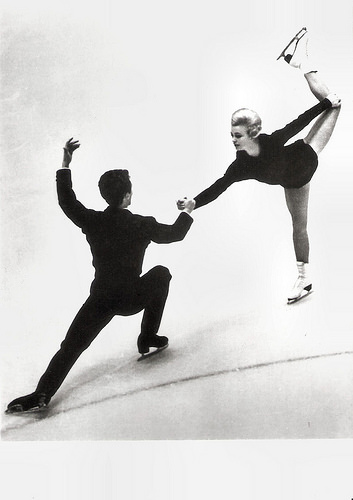
Czech postcard by Pressfoto, no. S 12/2, 1964. Photo: Zdenek Havelka. Kilius and Bäumler won a Silver Medal at the IX Olympic Winter Games in Innsbruck (1964).
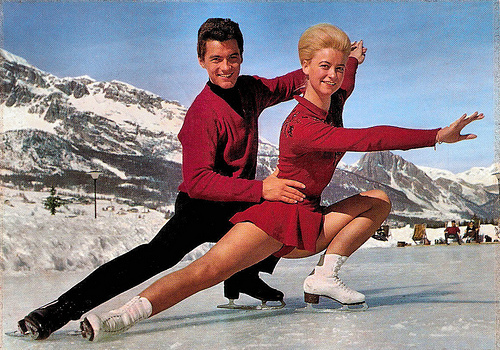
With Hans-Jürgen Bäumler. German postcard by Alpiner Fotoverlag A. Blumenthal, Garmisch-Partenkirchen, no. 110, 1964.
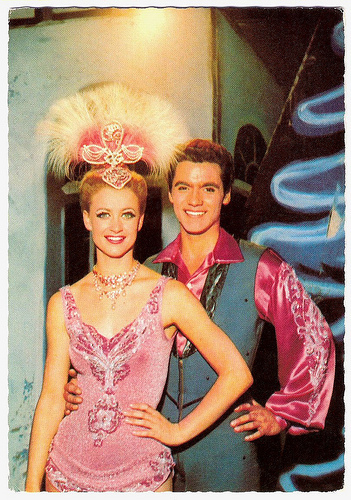
With Hans-Jürgen Bäumler. German postcard by ISV, no. H. 115.
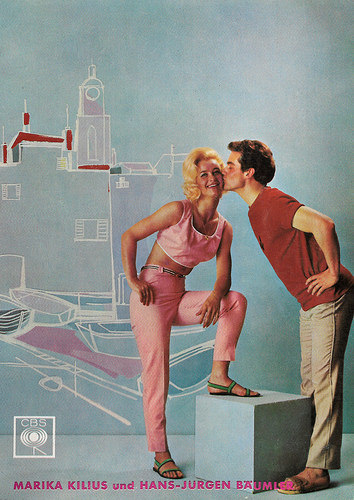
With Hans-Jürgen Bäumler . German promotion card by CBS.
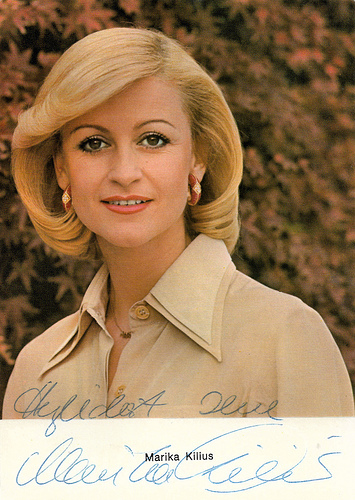
German postcard by Franz Josef Rüdel, Filmpostkartenverlag, Hamburg. Photo: Marina Bäumler.
German Female Athlete of the Year
Marika Kilius was born in 1943 in Frankfurt am Main, Germany. She was the daughter of a hairdresser and at the age of 4 she already learned to skate.
Kilius began as a singles skater but picked up pairs very early. Her first partner was Franz Ningel. They placed fourth at the 1956 Olympics and won the silver medal at the 1957 World Championships. Kilius was still a child when she was paired with Ningel, who was more than six years her senior. By 1957 she had grown to be taller than he was, which caused problems on their lifts, so the team split.
For a time following her split with Ningel, Kilius competed in artistic roller skating as a singles skater. She was the World Roller Lady Champion in 1958. Meanwhile, in 1957, Kilius began skating with Hans-Jürgen Bäumler under the tutelage of Erich Zeller.
Between 1958 and 1964, Kilius and Bäumler won the German Championships four times, European Championships six times and the World Championships two times. Their first World title, in 1963, followed cancellation of the 1961 event due to the crash of Sabena Flight 548 and a collision during their performance at the 1962 World Figure Skating Championships that forced them to withdraw.
Marika Kilius was voted the German female athlete of the year in 1959.
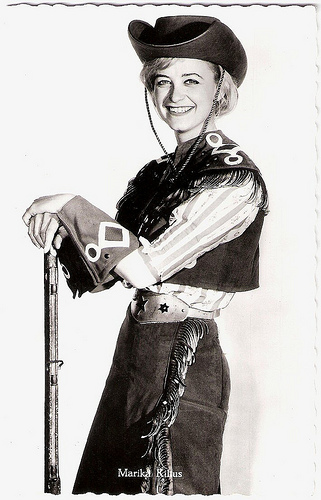
Dutch postcard, no. 1162. Photo: CBS Grammafoonplaten.
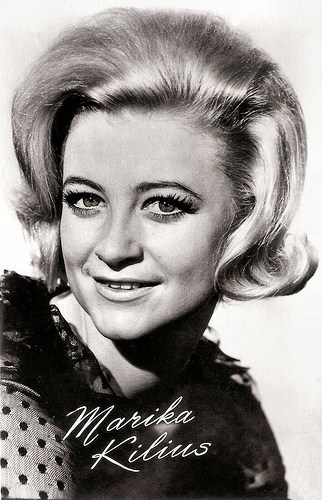
Dutch postcard by Muziek Parade, Hilversum, no. AX 6092.
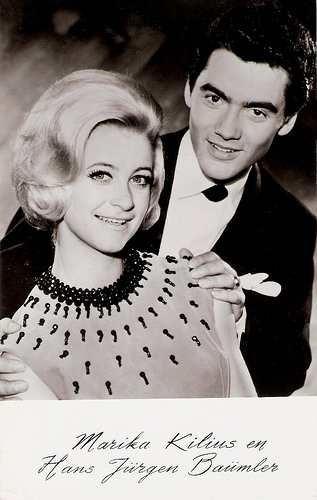
With Hans-Jürgen Bäumler . Dutch postcard by Uitg. en druk. 't Sticht, Utrecht, no. 6120.
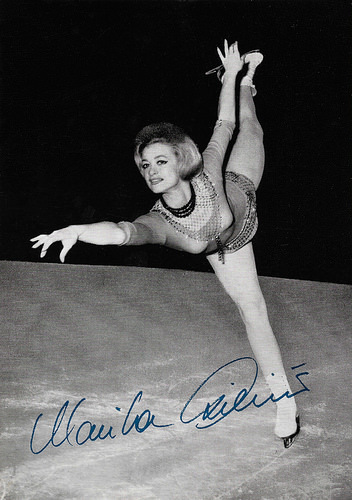
German autograph card. Photo: Fritz Frischmann, 1964. Here, Marika Kilius performed in the Wiener Eisrevue in Luxembourg.
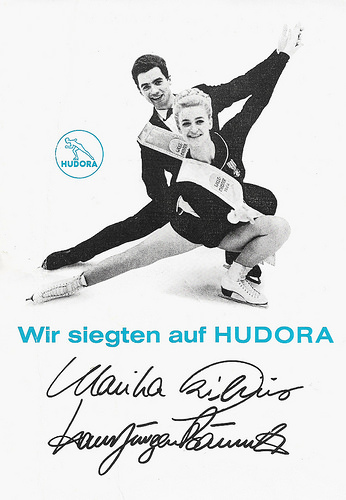
German promotion card by Hudora-Schlittschuhen (skates). Caption: Wir siegten auf Hudora (We won on Hudora).
Schlager Singers
Marika Kilius and Hans-Jürgen Bäumler also captured the silver medal at the Olympics twice, in 1960 and 1964. In 1966, it was alleged that the team had signed a professional skating contract before the 1964 Winter Olympics - against the rules at the time - and they were stripped of the medal.
In 1964 they had professionally skated for Holiday on Ice. The IOC dismissed the charges in 1987, reinstated the original results, and Kilius and Bäumler were re-awarded their silver medals.
Both Kilius and Bäumler became singers of Schlagers, the German version of pop songs. Her debut single, Wenn die Cowboys träumen (1964, When the Cowboys Dream), shot to number two in the German charts and spent four months in the top ten.
Also successful was her duet with Bäumler, Honeymoon in St. Tropez (1964). Reportedly her skating was better than her singing and her voice was replaced by that of background singer Leonie Brückner. Further lightweight solo singles failed to maintain the momentum.
That same year, Kilius suddenly married Werner Zahn, the son of a factory owner from Frankfurt am Main. This happened just before the premiere of the film Die große Kür/The Big Kür (Franz Antel, 1964) with Peter Kraus , in which director Franz Antel had wanted to present her and Bäumler as a new Traumpaar (romantic dream pair).
However, the film still became a huge success, and they made a sequel, Das große Glück/The Lucky Strike (Franz Antel, 1967) with Theo Lingen . They reunited for the comedy Einer spinnt immer/One always spins (Franz Antel, 1971) starring Georg Thomalla , in which they had cameo appearances.
Kilius divorced Werner Zahn, and her second marriage, to American businessman Jake Orfield, also ended in a divorce. She has two children, Sascha and Melanie Schäfer, and two grandchildren.
In 2008 she and Hans-Jürgen Bäumler reunited as jury members for the German TV show Dancing on Ice. A year later she had a supporting part in the film comedy Rabentage/Ravens Days (Thomas Haaf, 2009) and she continues to appear regularly on TV.
Marika Kilius introduced a cosmetics line, Beauty on Ice, in 2012, and in 2013, she presented her memoirs, Pirouettes des Lebens (Pirouettes of Life).
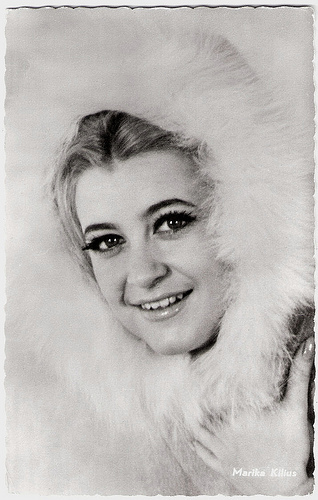
German postcard by Filmbilder-Vertrieb Ernst Freihoff, Essen, no. AX 5891. Photo: CBS-Schallplatten.
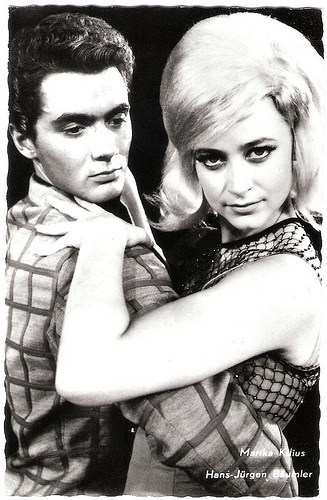
German postcard by Filmbilder-Vertrieb Ernst Freihoff, Essen, no AX 6160.
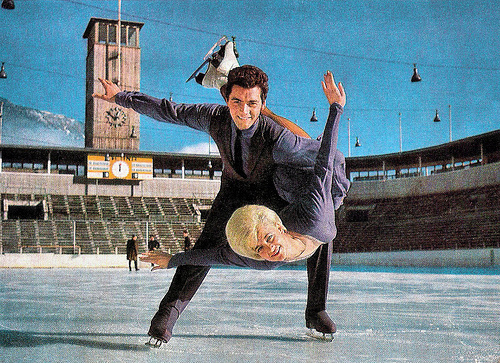
Vintage postcard. Photo: Schirner, Düsseldorf. Caption: Marika Kilius and Hans Jürgen Bäumler, World Ice-Skating Champions.
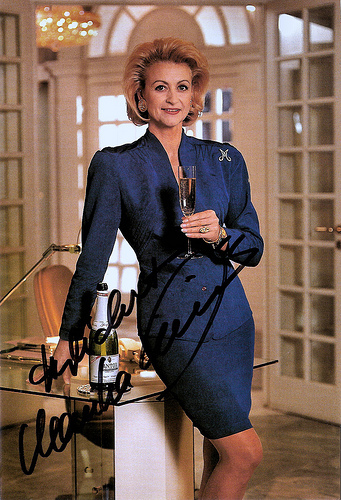
German autograph card by Cantor, Wiesbaden.
Marika Kilius sings Erst kam ein verliebter Blick (1965, First Came A Lovely Glance). Source: Megayoyo1992 (YouTube).
Marika Kilius and Hans-Jürgen Bäumler in Das grosse Glück (1967) with Eva Pawlik and the Wiener Eisrevue. Source: Erksun Koca (YouTube).
Sources: Ready Steady Girls!, Marika Kilius Offical Website, Wikipedia (English and German) and .

Czech postcard by Pressfoto, no. S 12/2, 1964. Photo: Zdenek Havelka. Kilius and Bäumler won a Silver Medal at the IX Olympic Winter Games in Innsbruck (1964).

With Hans-Jürgen Bäumler. German postcard by Alpiner Fotoverlag A. Blumenthal, Garmisch-Partenkirchen, no. 110, 1964.

With Hans-Jürgen Bäumler. German postcard by ISV, no. H. 115.

With Hans-Jürgen Bäumler . German promotion card by CBS.

German postcard by Franz Josef Rüdel, Filmpostkartenverlag, Hamburg. Photo: Marina Bäumler.
German Female Athlete of the Year
Marika Kilius was born in 1943 in Frankfurt am Main, Germany. She was the daughter of a hairdresser and at the age of 4 she already learned to skate.
Kilius began as a singles skater but picked up pairs very early. Her first partner was Franz Ningel. They placed fourth at the 1956 Olympics and won the silver medal at the 1957 World Championships. Kilius was still a child when she was paired with Ningel, who was more than six years her senior. By 1957 she had grown to be taller than he was, which caused problems on their lifts, so the team split.
For a time following her split with Ningel, Kilius competed in artistic roller skating as a singles skater. She was the World Roller Lady Champion in 1958. Meanwhile, in 1957, Kilius began skating with Hans-Jürgen Bäumler under the tutelage of Erich Zeller.
Between 1958 and 1964, Kilius and Bäumler won the German Championships four times, European Championships six times and the World Championships two times. Their first World title, in 1963, followed cancellation of the 1961 event due to the crash of Sabena Flight 548 and a collision during their performance at the 1962 World Figure Skating Championships that forced them to withdraw.
Marika Kilius was voted the German female athlete of the year in 1959.

Dutch postcard, no. 1162. Photo: CBS Grammafoonplaten.

Dutch postcard by Muziek Parade, Hilversum, no. AX 6092.

With Hans-Jürgen Bäumler . Dutch postcard by Uitg. en druk. 't Sticht, Utrecht, no. 6120.

German autograph card. Photo: Fritz Frischmann, 1964. Here, Marika Kilius performed in the Wiener Eisrevue in Luxembourg.

German promotion card by Hudora-Schlittschuhen (skates). Caption: Wir siegten auf Hudora (We won on Hudora).
Schlager Singers
Marika Kilius and Hans-Jürgen Bäumler also captured the silver medal at the Olympics twice, in 1960 and 1964. In 1966, it was alleged that the team had signed a professional skating contract before the 1964 Winter Olympics - against the rules at the time - and they were stripped of the medal.
In 1964 they had professionally skated for Holiday on Ice. The IOC dismissed the charges in 1987, reinstated the original results, and Kilius and Bäumler were re-awarded their silver medals.
Both Kilius and Bäumler became singers of Schlagers, the German version of pop songs. Her debut single, Wenn die Cowboys träumen (1964, When the Cowboys Dream), shot to number two in the German charts and spent four months in the top ten.
Also successful was her duet with Bäumler, Honeymoon in St. Tropez (1964). Reportedly her skating was better than her singing and her voice was replaced by that of background singer Leonie Brückner. Further lightweight solo singles failed to maintain the momentum.
That same year, Kilius suddenly married Werner Zahn, the son of a factory owner from Frankfurt am Main. This happened just before the premiere of the film Die große Kür/The Big Kür (Franz Antel, 1964) with Peter Kraus , in which director Franz Antel had wanted to present her and Bäumler as a new Traumpaar (romantic dream pair).
However, the film still became a huge success, and they made a sequel, Das große Glück/The Lucky Strike (Franz Antel, 1967) with Theo Lingen . They reunited for the comedy Einer spinnt immer/One always spins (Franz Antel, 1971) starring Georg Thomalla , in which they had cameo appearances.
Kilius divorced Werner Zahn, and her second marriage, to American businessman Jake Orfield, also ended in a divorce. She has two children, Sascha and Melanie Schäfer, and two grandchildren.
In 2008 she and Hans-Jürgen Bäumler reunited as jury members for the German TV show Dancing on Ice. A year later she had a supporting part in the film comedy Rabentage/Ravens Days (Thomas Haaf, 2009) and she continues to appear regularly on TV.
Marika Kilius introduced a cosmetics line, Beauty on Ice, in 2012, and in 2013, she presented her memoirs, Pirouettes des Lebens (Pirouettes of Life).

German postcard by Filmbilder-Vertrieb Ernst Freihoff, Essen, no. AX 5891. Photo: CBS-Schallplatten.

German postcard by Filmbilder-Vertrieb Ernst Freihoff, Essen, no AX 6160.

Vintage postcard. Photo: Schirner, Düsseldorf. Caption: Marika Kilius and Hans Jürgen Bäumler, World Ice-Skating Champions.

German autograph card by Cantor, Wiesbaden.
Marika Kilius sings Erst kam ein verliebter Blick (1965, First Came A Lovely Glance). Source: Megayoyo1992 (YouTube).
Marika Kilius and Hans-Jürgen Bäumler in Das grosse Glück (1967) with Eva Pawlik and the Wiener Eisrevue. Source: Erksun Koca (YouTube).
Sources: Ready Steady Girls!, Marika Kilius Offical Website, Wikipedia (English and German) and .
Published on July 02, 2018 22:00
July 1, 2018
Pierre de Guingand
Pierre de Guingand (1885-1964) was a French stage and film actor in the 1920s and 1930s, most noteworthy for performing elegant rich men in films like Au bonheur des dames (1929) and Ich küsse Ihre Hand, Madame (1929).
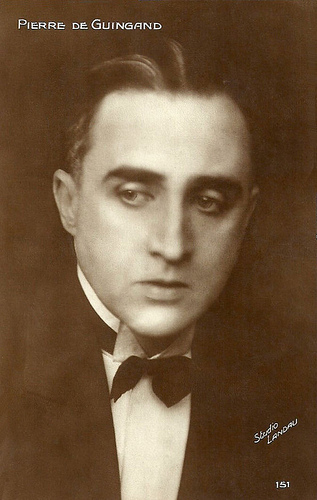
French postcard by Cinémagazine, no. 151. Photo: Studio Landau.
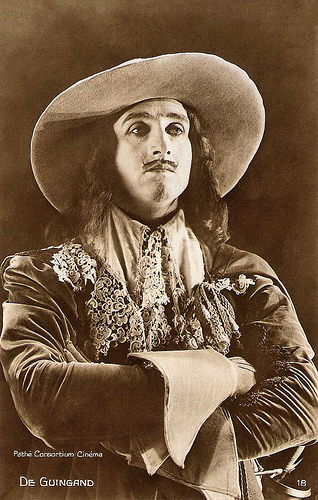
French postcard by Cinémagazine Edition, no. 18. Photo: Pathé Consortium Cinema. Publicity still for Les Trois Mousquetaires (Henri Diamant Berger, 1921).
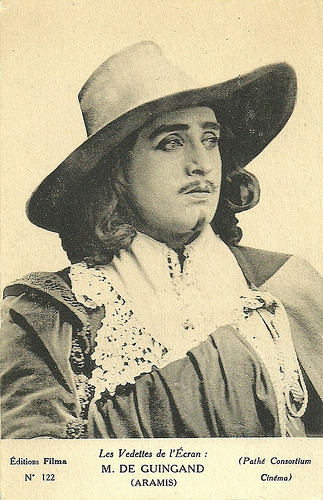
French postcard in the series Les Vedettes de l'Ecran by Editions Filma, no. 122. Photo: Pathé Consortium Cinéma. Pierre de Guingand as Aramis in the period piece serial Les trois mousquetaires (Henri Diamant-Berger, 1921).
Musketeer Aramis
Octave-Pierre Deguingand aka Pierre de Guingand was born in Paris in 1885.
In 1908, he probably debuted on stage in the play Ramuntcho by Pierre Loti, directed by André Antoine at the Théâtre de l'Odéon. A few years later he performed in the play La Pèlerine écossaise (1914) by Sacha Guitry , at the Théâtre des Bouffes-Parisiens.
In 1921 Guingand played in Une danseuse est morte by Charles Le Bargy , at the Théâtre des Galeries Saint Hubert.
Also in 1921, Guingand debuted in the cinema and had a big role right away as Aramis in the 12 episode film Les Trois Mousquetaires/The Three Musketeers (Henri Diamant-Berger, 1921). He played Aramis again in the sequel Vingt ans après/The Return of the Musketeers (Henri Diamant-Berger, 1922), a 10 episode serial.
Guingand stayed on with Diamant-Berger for the subsequent films Le Mauvais Garçon/Bad Boy (Henri Diamant-Berger, 1922) with Maurice Chevalier , L'Emprise/The influence (Henri Diamant-Berger, 1923), and Le Roi de la vitesse/King of the speed (Henri Diamant-Berger, 1923).
In the following year, De Guingand played Lodovico Gonzaga in Le Vert Galant/The Courteous Green (René Leprince, 1924), this time a film in 8 episodes, and in 1925 he performed as marquis d'Aurilly in the 8 episode serial Fanfan La Tulipe/Fan Fan the Tulip (René Leprince, 1924), starring Aimé Simon-Girard .
In 1926-1927, De Guingand was absent from the screen, but he performed on stage in plays such as Le Prince charmant (Prince Charming, 1925) by Tristan Bernard, at the Théâtre Michel, and Un perdreau de l'année (A young partridge of the year, 1926), again by Tristan Bernard, and again at the Théâtre Michel.
In 1928, Guingand returned to the set for L'Équipage/Last Flight (Maurice Tourneur, 1928), starring Charles Vanel and Jean Murat , and La Possession/The Ownership (Léonce Perret, 1928) with Italian film diva Francesca Bertini in the female lead.
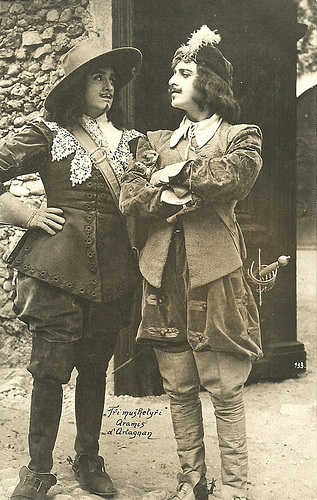
French postcard, no. 133. Pierre de Guingand as Aramis and Aimé Simon-Girard as D'Artagnan in Les trois mousquetaires/The Three Musketeers (Henri Diamant-Berger, 1921).
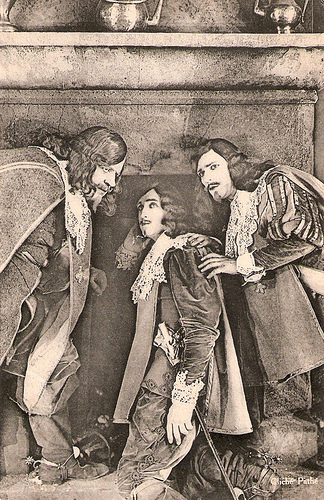
French postcard by M. Le Deley, Paris. Photo: still from Les Trois Mousquetaires/The Three Musketeers (Henri Diamant Berger, 1921).

French postcard. Photo: Pathé. Publicity still for Vingt ans après/The Return of the Musketeers (Henri Diamant-Berger, 1922). The four musketeers: Porthos ( Charles Martinelli ), Aramis (Pierre de Guingand), Athos ( Henri Rollan ), and D'Artagnan (Jean Yonnel).
Marlene Dietrich's Ex-Husband
In the late silent film Au bonheur des dames/In the happiness of the ladies (Julien Duvivier, 1929), Pierre de Guingand played Octave Mouret, the rich owner of the department store Au Bonheur des dames, who falls for a young mannequin, Denise ( Dita Parlo ). Her uncle (Armand Bour), however, owns the little shop Mouret wants to tear down for the expansion of his own department store.
De Guingand also made another remarkable late silent performance in Germany in Ich küsse ihre hand, Madame/I Kiss Your Hand Madame (Robert Land, 1929) starring Marlene Dietrich . Guingand plays the ex-husband of Laurette Gerard (Dietrich), who is still infatuated with her despite the divorce. Laurette starts an affair with a gentleman ( Harry Liedtke ) until she discovers he works as a waiter. In reality the waiter is a Russian count though.
In 1931, De Guingand played in the French version of the early sound film Der Ball, Le bal (Wilhelm Thiele, 1931), starring Germaine Dermoz and Danielle Darrieux . Next came La Chance/Luck (René Guissart, 1931) with Marie Bell , the comedy Une faible femme/A Weak Woman (Max de Vaucorbeil, 1932) with Meg Lemonnier , and Chourinette (André Hugon, 1934) with Mireille.
He played a supporting part in the classic Le Grand jeu/The big game (Jacques Feyder, 1933) with Marie Bell .
Among his later films were L'Appel du silence/The Call (Léon Poirier, 1936) with Jean Yonnel as North Africa explorer Charles de Foucauld and Guingand as General Laperrine, Sarati, le terrible/Sarati the Terrible (André Hugon, 1937) with Harry Baur in the title role, and finally Remontons les Champs-Élysées/Champs Elysees (Sacha Guitry, 1938) with Guitry himself in a multiple lead (a.o. Louis XV and Napoleon III) and Guingand as baron de Vitry.
Occasionally Guingand continued stage acting as well, as in Le Cyclone (1931) by Somerset Maugham, directed by Jacques Baumer, at the Théâtre des Ambassadeurs, and Tout n'est pas noir (1941) by André Birabeau, directed by Robert Blome, at the Théâtre Daunou.
Pierre Guingand died in 1964 in Versailles. He was 79.

French postcard by Editions Cinémagazine no. 43. Photo: Pathé Consortium Cinéma. Pierre de Guingand as Aramis in Vingt ans après/The Return of the Musketeers (Henri Diamant-Berger, 1922).
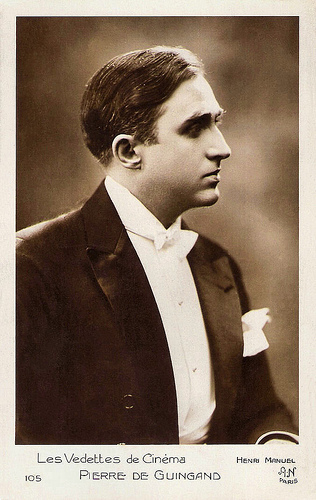
French postcard in the Les Vedettes du Cinéma series by A.N., Paris, no. 105. Photo: Henri Manuel.
Sources: Ciné-ressources (French), Wikipedia (French) and .

French postcard by Cinémagazine, no. 151. Photo: Studio Landau.

French postcard by Cinémagazine Edition, no. 18. Photo: Pathé Consortium Cinema. Publicity still for Les Trois Mousquetaires (Henri Diamant Berger, 1921).

French postcard in the series Les Vedettes de l'Ecran by Editions Filma, no. 122. Photo: Pathé Consortium Cinéma. Pierre de Guingand as Aramis in the period piece serial Les trois mousquetaires (Henri Diamant-Berger, 1921).
Musketeer Aramis
Octave-Pierre Deguingand aka Pierre de Guingand was born in Paris in 1885.
In 1908, he probably debuted on stage in the play Ramuntcho by Pierre Loti, directed by André Antoine at the Théâtre de l'Odéon. A few years later he performed in the play La Pèlerine écossaise (1914) by Sacha Guitry , at the Théâtre des Bouffes-Parisiens.
In 1921 Guingand played in Une danseuse est morte by Charles Le Bargy , at the Théâtre des Galeries Saint Hubert.
Also in 1921, Guingand debuted in the cinema and had a big role right away as Aramis in the 12 episode film Les Trois Mousquetaires/The Three Musketeers (Henri Diamant-Berger, 1921). He played Aramis again in the sequel Vingt ans après/The Return of the Musketeers (Henri Diamant-Berger, 1922), a 10 episode serial.
Guingand stayed on with Diamant-Berger for the subsequent films Le Mauvais Garçon/Bad Boy (Henri Diamant-Berger, 1922) with Maurice Chevalier , L'Emprise/The influence (Henri Diamant-Berger, 1923), and Le Roi de la vitesse/King of the speed (Henri Diamant-Berger, 1923).
In the following year, De Guingand played Lodovico Gonzaga in Le Vert Galant/The Courteous Green (René Leprince, 1924), this time a film in 8 episodes, and in 1925 he performed as marquis d'Aurilly in the 8 episode serial Fanfan La Tulipe/Fan Fan the Tulip (René Leprince, 1924), starring Aimé Simon-Girard .
In 1926-1927, De Guingand was absent from the screen, but he performed on stage in plays such as Le Prince charmant (Prince Charming, 1925) by Tristan Bernard, at the Théâtre Michel, and Un perdreau de l'année (A young partridge of the year, 1926), again by Tristan Bernard, and again at the Théâtre Michel.
In 1928, Guingand returned to the set for L'Équipage/Last Flight (Maurice Tourneur, 1928), starring Charles Vanel and Jean Murat , and La Possession/The Ownership (Léonce Perret, 1928) with Italian film diva Francesca Bertini in the female lead.

French postcard, no. 133. Pierre de Guingand as Aramis and Aimé Simon-Girard as D'Artagnan in Les trois mousquetaires/The Three Musketeers (Henri Diamant-Berger, 1921).

French postcard by M. Le Deley, Paris. Photo: still from Les Trois Mousquetaires/The Three Musketeers (Henri Diamant Berger, 1921).

French postcard. Photo: Pathé. Publicity still for Vingt ans après/The Return of the Musketeers (Henri Diamant-Berger, 1922). The four musketeers: Porthos ( Charles Martinelli ), Aramis (Pierre de Guingand), Athos ( Henri Rollan ), and D'Artagnan (Jean Yonnel).
Marlene Dietrich's Ex-Husband
In the late silent film Au bonheur des dames/In the happiness of the ladies (Julien Duvivier, 1929), Pierre de Guingand played Octave Mouret, the rich owner of the department store Au Bonheur des dames, who falls for a young mannequin, Denise ( Dita Parlo ). Her uncle (Armand Bour), however, owns the little shop Mouret wants to tear down for the expansion of his own department store.
De Guingand also made another remarkable late silent performance in Germany in Ich küsse ihre hand, Madame/I Kiss Your Hand Madame (Robert Land, 1929) starring Marlene Dietrich . Guingand plays the ex-husband of Laurette Gerard (Dietrich), who is still infatuated with her despite the divorce. Laurette starts an affair with a gentleman ( Harry Liedtke ) until she discovers he works as a waiter. In reality the waiter is a Russian count though.
In 1931, De Guingand played in the French version of the early sound film Der Ball, Le bal (Wilhelm Thiele, 1931), starring Germaine Dermoz and Danielle Darrieux . Next came La Chance/Luck (René Guissart, 1931) with Marie Bell , the comedy Une faible femme/A Weak Woman (Max de Vaucorbeil, 1932) with Meg Lemonnier , and Chourinette (André Hugon, 1934) with Mireille.
He played a supporting part in the classic Le Grand jeu/The big game (Jacques Feyder, 1933) with Marie Bell .
Among his later films were L'Appel du silence/The Call (Léon Poirier, 1936) with Jean Yonnel as North Africa explorer Charles de Foucauld and Guingand as General Laperrine, Sarati, le terrible/Sarati the Terrible (André Hugon, 1937) with Harry Baur in the title role, and finally Remontons les Champs-Élysées/Champs Elysees (Sacha Guitry, 1938) with Guitry himself in a multiple lead (a.o. Louis XV and Napoleon III) and Guingand as baron de Vitry.
Occasionally Guingand continued stage acting as well, as in Le Cyclone (1931) by Somerset Maugham, directed by Jacques Baumer, at the Théâtre des Ambassadeurs, and Tout n'est pas noir (1941) by André Birabeau, directed by Robert Blome, at the Théâtre Daunou.
Pierre Guingand died in 1964 in Versailles. He was 79.

French postcard by Editions Cinémagazine no. 43. Photo: Pathé Consortium Cinéma. Pierre de Guingand as Aramis in Vingt ans après/The Return of the Musketeers (Henri Diamant-Berger, 1922).

French postcard in the Les Vedettes du Cinéma series by A.N., Paris, no. 105. Photo: Henri Manuel.
Sources: Ciné-ressources (French), Wikipedia (French) and .
Published on July 01, 2018 22:00
June 30, 2018
Jean-Pierre Aumont
French Film star Jean-Pierre Aumont (1909-2001) was the stylish gentleman in more than 100 films. The blond-haired, blue-eyed leading man wooed and wed during his film career some of the most beautiful actresses - on screen and in real life too.

French postcard by Viny, no. 27. Photo: Star. See also this card.

French postcard by Viny, no. 85. Photo: Studio Rudolph.

French postcard by Editions P.I., no. 58. Photo: Universal International.
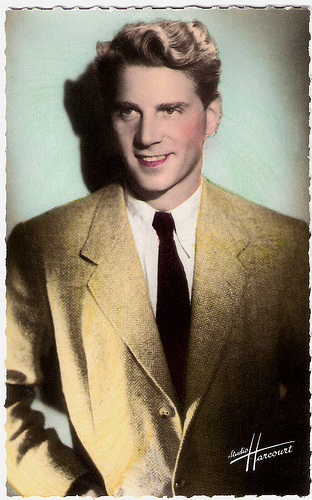
French postcard by Editions O.P., Paris no. 45. Photo: Studio Harcourt.
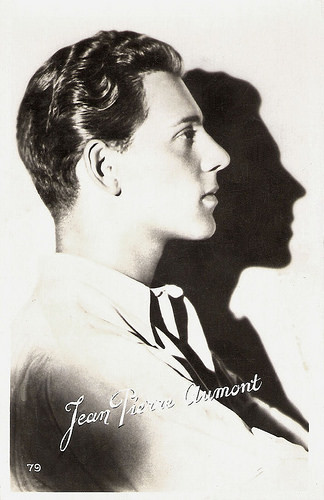
French postcard, no. 79.
The Infernal Machine
Jean-Pierre - or Jean Pierre - Aumont was born as Jean-Pierre Philippe Salomons in Paris in 1909 (some sources say 1911) into a prosperous Jewish family with a passion for the theatre. His parents were Dutch entrepreneur Alexandre Salomons and French actress Suzanne Cahen.
His mother's uncle, stage actor, Georges Berr of the Comédie Francaise, gave Jean-Pierre a glimpse into the theatre world. His younger brother Francois grew up to become director Francois Villiers. Despite many objections from his family, Jean-Pierre went to study drama at the Paris Conservatory at the age of sixteen.
His stage debut occurred in 1930 and his film debut came in Jean de la Lune/Jean of the Moon (Jean Choux, 1931) opposite Michel Simon .
His career-defining role was Oedipus in Louis Jouvet's acclaimed 1934 stage production of La Machine Infernale by Jean Cocteau. Cocteau had personally selected the exceptionally good-looking Aumont for the part. La Machine Infernale took on an almost cult-like following among the youth of Paris and was considered a greatly influential breakthrough in the French theatre.
From there Aumont’s career both on stage and screen began to take off. James Kirkup writes in his 2001 obituary in The Independent : "at first he played healthy young sporting types with subtle elegance and a light romantic touch that fluttered feminine hearts all over Europe."
His first film hit was Lac aux Dames/Ladies Lake (Marc Allégret, 1934) He played an athletic swimming instructor opposite Simone Simon . The role, originally intended for Johnny Weissmuller , "showed off his sporting physique to discreet advantage, and gave him the chance to show a rare gift for comedy", according to Kirkup.
Throughout the 1930s, he was a rising star in French cinema, starring alongside Louis Jouvet in Drôle de Drame/Bizarre, Bizarre (Marcel Carné, 1937) in which he personified a caustic-tongued milkman, and Hôtel du Nord (Marcel Carné, 1938), playing against character as the useless lover of Annabella .
Then World War II broke out and his career was cut short.
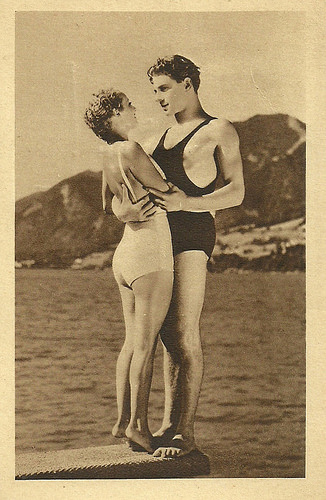
French postcard by Imprimerie A. Breger Frères, Paris. Photo: publicity still for Lac au dames/Ladies Lake (Marc Allégret, 1934). The card was issued for the cinema Max-Linder Pathé, 24, Boulevard Poissonière, Paris, where the film was presented 14-20 September 1934. Lac au dames/Ladies Lake is situated at Lake Konstanz. In Germany the film was presented as Hell in Frauensee. Frauensee was the title of the novel by Vicki Baum on which the film was based. The actress Aumont is holding in his arms must be Rosine Dérean.
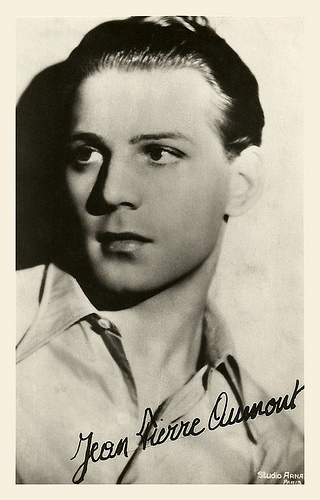
French postcard. Photo: Studio Arna, Paris.
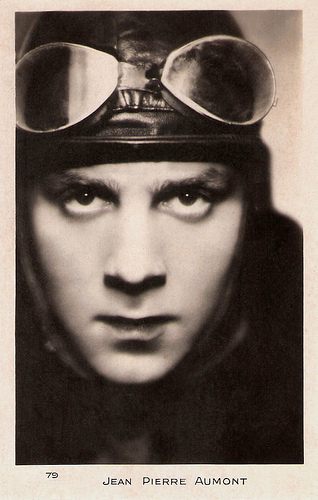
French postcard, no. 79.
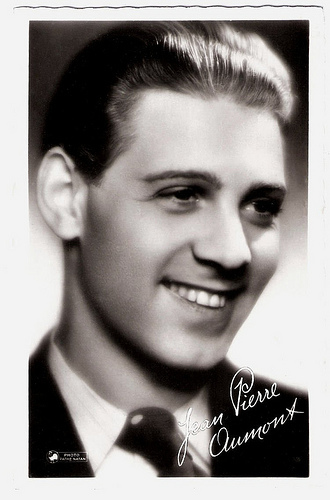
French postcard by Editions et Publications cinématographiques, no. 33. Photo: Pathé Natan.
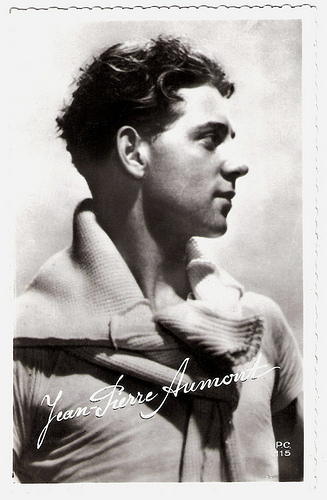
French postcard by P.C., Paris, no. 115.
Marrying the Queen of Technicolor
When the Nazis occupied France in 1940, Jean-Pierre Aumont fled to the US because of his Jewish origins. In Hollywood he began to work in anti-Nazi propaganda films like The Cross of Lorraine (Tay Garnett, 1943).
At Metro-Goldwyn-Mayer, he enjoyed a successful, if routine, film career. His love life was anything but routine - he almost married Hedy Lamarr and in 1943 he did marry exotic Dominican actress Maria Montez , known as 'the Queen of Technicolor'.
After only one month of marriage, he left the US to join the Free French Forces. He was sent to North Africa and participated in Operation Torch, specifically in Tunisia. He later moved with the Allied armies through Italy and France. He was seriously injured when his Jeep was blown up by a landmined bridge. French Brigadier General Charles-Joseph Brosset, also in the Jeep, was killed.
After the war, Aumont returned to France with Maria Montez . Soon they appeared together in Siren of Atlantis (Gregg Tallas, 1949), a remake of L'Atlantide, with Montez excellent as Queen Antinea. The couple continued to work together in films like Hans le Marin/Hans the Sailor (1949) directed by Aumont's brother, Francois Villiers, and La vendetta del corsaro/Revenge of the Pirates (Primo Zeglio, 1951).
In 1951, Maria suddenly died after fainting and drowning in her bath. After his wife's tragic death, Aumont continued to work both in Hollywood and Europe. He co-starred as the magician in Lili (Charles Walters, 1953) with Leslie Caron , and the film was an enormous success.
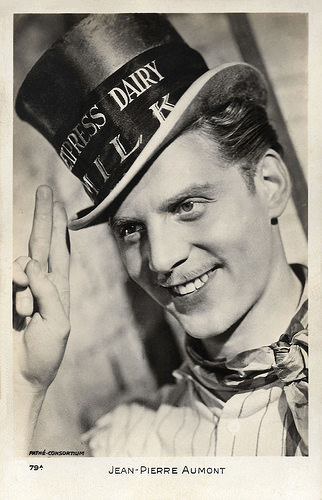
French postcard by Chantal, Paris, no. 79A. Photo: Pathé-Consortium. Publicity still for Drôle de drame/Bizarre, Bizarre (Marcel Carné, 1937).

With Maria Montez . Dutch postcard, no. 3117. Photo: Universal International.
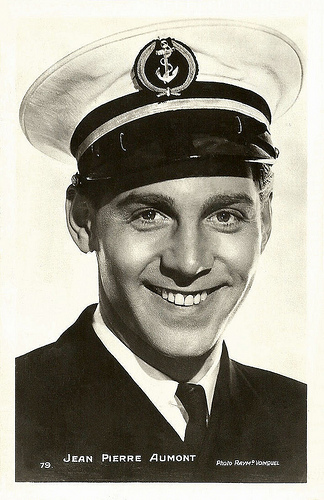
French postcard, no. 79. Photo: Raymond Voinquel.
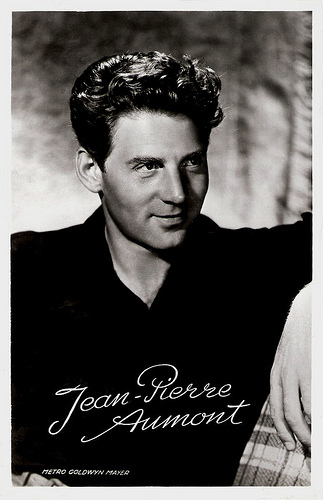
Dutch postcard by Takken, Utrecht, no. 3311. Photo: Metro Goldwyn Mayer.
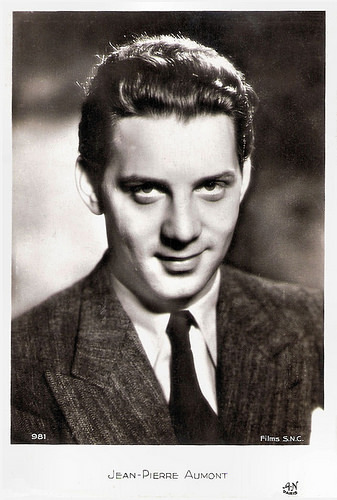
French postcard by A.N., Paris, no. 981. Photo: S.N.C.
Ageing and somewhat philosophical Matinee Idol
In 1956 Jean-Pierre Aumont married Italian actress Marisa Pavan , twin sister of Pier Angeli and star of such highly acclaimed films as The Man in the Grey Flannel Suit (Nunnally Johnson, 1956) and The Rose Tattoo (Daniel Mann, 1955).
The two starred in one film together, John Paul Jones (John Farrow, 1959) in which Pavan played the romantic lead to Robert Stack and Aumont made a cameo as Louis XVI. They were divorced in 1962, but later they remarried and remained happily married until Aumont's death.
In the 1960s and 1970s, Aumont appeared in the stage production of Gigi and the stage production and the later film adaptation of Des journées entières dans les arbres/Entire Days in the Trees (Marguerite Duras, 1977) as the world-weary, melancholy son of Madeleine Renaud .
With François Truffaut, he worked on La Nuit américaine/Day for Night (1973), a masterwork about the rigours of film making. Aumont played the ageing and somewhat philosophical matinee idol, Alexandre. He also co-starred with Michèle Morgan in Le chat et la souris/Cat and Mouse (Claude Lelouch, 1975).
Later screen work includes Yves Boisset's anti-military Allons z'enfants (1981), the TV mini-series A Tale of Two Cities (Philippe Monnier, 1989) and the Merchant-Ivory films Jefferson in Paris (James Ivory, 1995) and The Proprietor (Ismail Merchant, 1996).
In 1991, Aumont was decorated with the Legion d'Honneur and the Croix de Guerre, because of his bravery during World War II. And in 1992 followed an honorary César Award.
In 2001, Jean-Pierre Aumont died of a heart attack at the age of 90. He and Maria Montez had a daughter, Marie-Christine, better known as actress Tina Aumont .
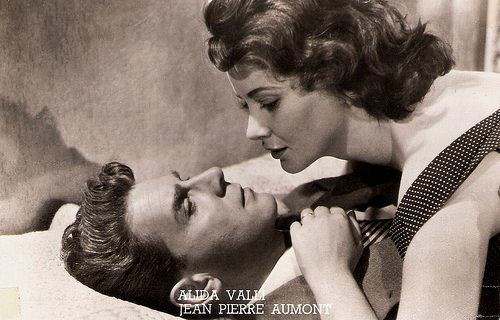
Vintage Postcard, no. 952. Publicity still for Ultimo incontro/Last Meeting (Gianni Franciolini, 1951) with Alida Valli.
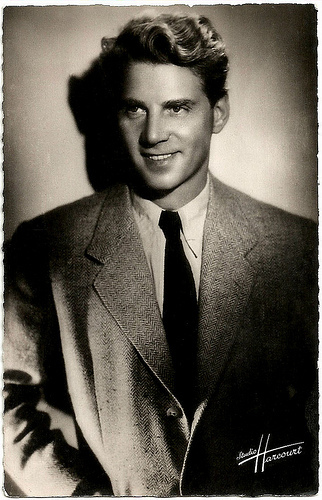
French postcard. Photo: Studio Harcourt.
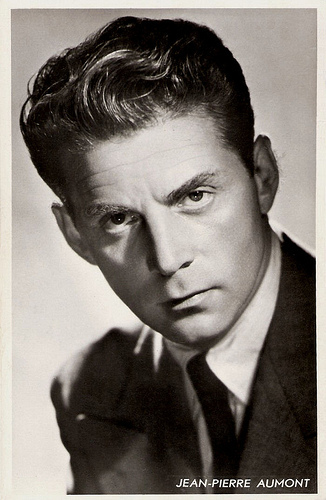
Dutch postcard by Takken, no. 1937.
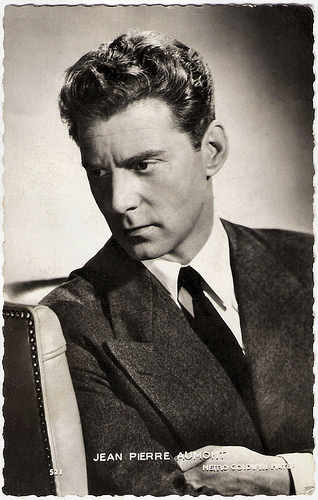
French postcard by Editions P.I., Paris, no. 521, 1954. Photo: Metro Goldwyn Mayer.
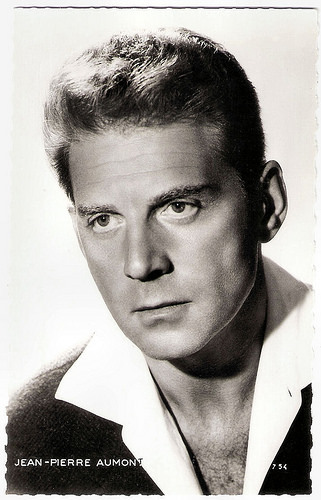
French postcard by Editions P.I., Paris, no. 754. Photo: Sam Lévin.
Sources: (IMDb), James Kirkup (The Independent), Wikipedia, and .

French postcard by Viny, no. 27. Photo: Star. See also this card.

French postcard by Viny, no. 85. Photo: Studio Rudolph.

French postcard by Editions P.I., no. 58. Photo: Universal International.

French postcard by Editions O.P., Paris no. 45. Photo: Studio Harcourt.

French postcard, no. 79.
The Infernal Machine
Jean-Pierre - or Jean Pierre - Aumont was born as Jean-Pierre Philippe Salomons in Paris in 1909 (some sources say 1911) into a prosperous Jewish family with a passion for the theatre. His parents were Dutch entrepreneur Alexandre Salomons and French actress Suzanne Cahen.
His mother's uncle, stage actor, Georges Berr of the Comédie Francaise, gave Jean-Pierre a glimpse into the theatre world. His younger brother Francois grew up to become director Francois Villiers. Despite many objections from his family, Jean-Pierre went to study drama at the Paris Conservatory at the age of sixteen.
His stage debut occurred in 1930 and his film debut came in Jean de la Lune/Jean of the Moon (Jean Choux, 1931) opposite Michel Simon .
His career-defining role was Oedipus in Louis Jouvet's acclaimed 1934 stage production of La Machine Infernale by Jean Cocteau. Cocteau had personally selected the exceptionally good-looking Aumont for the part. La Machine Infernale took on an almost cult-like following among the youth of Paris and was considered a greatly influential breakthrough in the French theatre.
From there Aumont’s career both on stage and screen began to take off. James Kirkup writes in his 2001 obituary in The Independent : "at first he played healthy young sporting types with subtle elegance and a light romantic touch that fluttered feminine hearts all over Europe."
His first film hit was Lac aux Dames/Ladies Lake (Marc Allégret, 1934) He played an athletic swimming instructor opposite Simone Simon . The role, originally intended for Johnny Weissmuller , "showed off his sporting physique to discreet advantage, and gave him the chance to show a rare gift for comedy", according to Kirkup.
Throughout the 1930s, he was a rising star in French cinema, starring alongside Louis Jouvet in Drôle de Drame/Bizarre, Bizarre (Marcel Carné, 1937) in which he personified a caustic-tongued milkman, and Hôtel du Nord (Marcel Carné, 1938), playing against character as the useless lover of Annabella .
Then World War II broke out and his career was cut short.

French postcard by Imprimerie A. Breger Frères, Paris. Photo: publicity still for Lac au dames/Ladies Lake (Marc Allégret, 1934). The card was issued for the cinema Max-Linder Pathé, 24, Boulevard Poissonière, Paris, where the film was presented 14-20 September 1934. Lac au dames/Ladies Lake is situated at Lake Konstanz. In Germany the film was presented as Hell in Frauensee. Frauensee was the title of the novel by Vicki Baum on which the film was based. The actress Aumont is holding in his arms must be Rosine Dérean.

French postcard. Photo: Studio Arna, Paris.

French postcard, no. 79.

French postcard by Editions et Publications cinématographiques, no. 33. Photo: Pathé Natan.

French postcard by P.C., Paris, no. 115.
Marrying the Queen of Technicolor
When the Nazis occupied France in 1940, Jean-Pierre Aumont fled to the US because of his Jewish origins. In Hollywood he began to work in anti-Nazi propaganda films like The Cross of Lorraine (Tay Garnett, 1943).
At Metro-Goldwyn-Mayer, he enjoyed a successful, if routine, film career. His love life was anything but routine - he almost married Hedy Lamarr and in 1943 he did marry exotic Dominican actress Maria Montez , known as 'the Queen of Technicolor'.
After only one month of marriage, he left the US to join the Free French Forces. He was sent to North Africa and participated in Operation Torch, specifically in Tunisia. He later moved with the Allied armies through Italy and France. He was seriously injured when his Jeep was blown up by a landmined bridge. French Brigadier General Charles-Joseph Brosset, also in the Jeep, was killed.
After the war, Aumont returned to France with Maria Montez . Soon they appeared together in Siren of Atlantis (Gregg Tallas, 1949), a remake of L'Atlantide, with Montez excellent as Queen Antinea. The couple continued to work together in films like Hans le Marin/Hans the Sailor (1949) directed by Aumont's brother, Francois Villiers, and La vendetta del corsaro/Revenge of the Pirates (Primo Zeglio, 1951).
In 1951, Maria suddenly died after fainting and drowning in her bath. After his wife's tragic death, Aumont continued to work both in Hollywood and Europe. He co-starred as the magician in Lili (Charles Walters, 1953) with Leslie Caron , and the film was an enormous success.

French postcard by Chantal, Paris, no. 79A. Photo: Pathé-Consortium. Publicity still for Drôle de drame/Bizarre, Bizarre (Marcel Carné, 1937).

With Maria Montez . Dutch postcard, no. 3117. Photo: Universal International.

French postcard, no. 79. Photo: Raymond Voinquel.

Dutch postcard by Takken, Utrecht, no. 3311. Photo: Metro Goldwyn Mayer.

French postcard by A.N., Paris, no. 981. Photo: S.N.C.
Ageing and somewhat philosophical Matinee Idol
In 1956 Jean-Pierre Aumont married Italian actress Marisa Pavan , twin sister of Pier Angeli and star of such highly acclaimed films as The Man in the Grey Flannel Suit (Nunnally Johnson, 1956) and The Rose Tattoo (Daniel Mann, 1955).
The two starred in one film together, John Paul Jones (John Farrow, 1959) in which Pavan played the romantic lead to Robert Stack and Aumont made a cameo as Louis XVI. They were divorced in 1962, but later they remarried and remained happily married until Aumont's death.
In the 1960s and 1970s, Aumont appeared in the stage production of Gigi and the stage production and the later film adaptation of Des journées entières dans les arbres/Entire Days in the Trees (Marguerite Duras, 1977) as the world-weary, melancholy son of Madeleine Renaud .
With François Truffaut, he worked on La Nuit américaine/Day for Night (1973), a masterwork about the rigours of film making. Aumont played the ageing and somewhat philosophical matinee idol, Alexandre. He also co-starred with Michèle Morgan in Le chat et la souris/Cat and Mouse (Claude Lelouch, 1975).
Later screen work includes Yves Boisset's anti-military Allons z'enfants (1981), the TV mini-series A Tale of Two Cities (Philippe Monnier, 1989) and the Merchant-Ivory films Jefferson in Paris (James Ivory, 1995) and The Proprietor (Ismail Merchant, 1996).
In 1991, Aumont was decorated with the Legion d'Honneur and the Croix de Guerre, because of his bravery during World War II. And in 1992 followed an honorary César Award.
In 2001, Jean-Pierre Aumont died of a heart attack at the age of 90. He and Maria Montez had a daughter, Marie-Christine, better known as actress Tina Aumont .

Vintage Postcard, no. 952. Publicity still for Ultimo incontro/Last Meeting (Gianni Franciolini, 1951) with Alida Valli.

French postcard. Photo: Studio Harcourt.

Dutch postcard by Takken, no. 1937.

French postcard by Editions P.I., Paris, no. 521, 1954. Photo: Metro Goldwyn Mayer.

French postcard by Editions P.I., Paris, no. 754. Photo: Sam Lévin.
Sources: (IMDb), James Kirkup (The Independent), Wikipedia, and .
Published on June 30, 2018 22:00
Paul van Yperen's Blog
- Paul van Yperen's profile
- 13 followers
Paul van Yperen isn't a Goodreads Author
(yet),
but they
do have a blog,
so here are some recent posts imported from
their feed.



